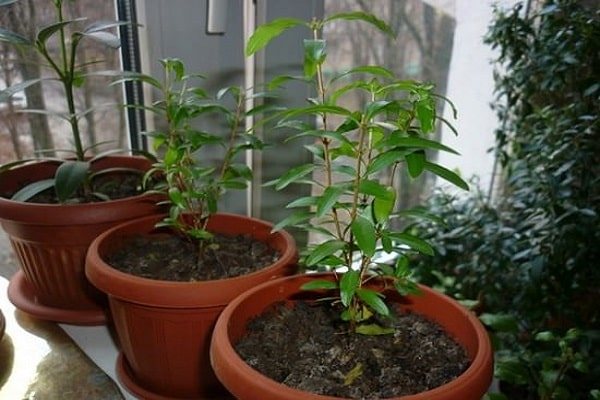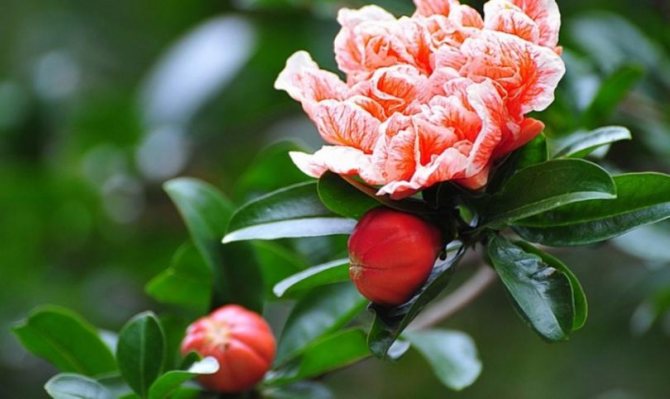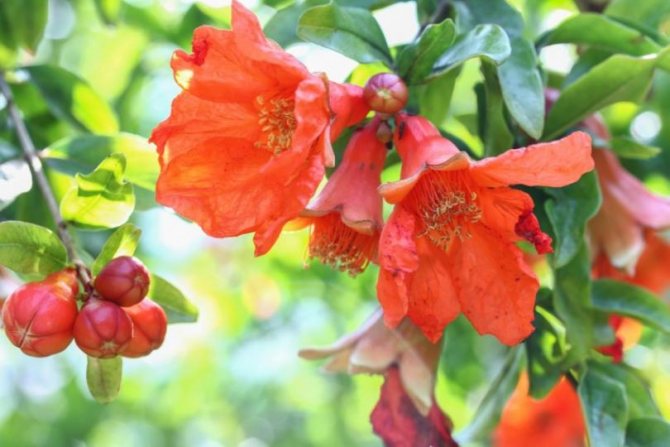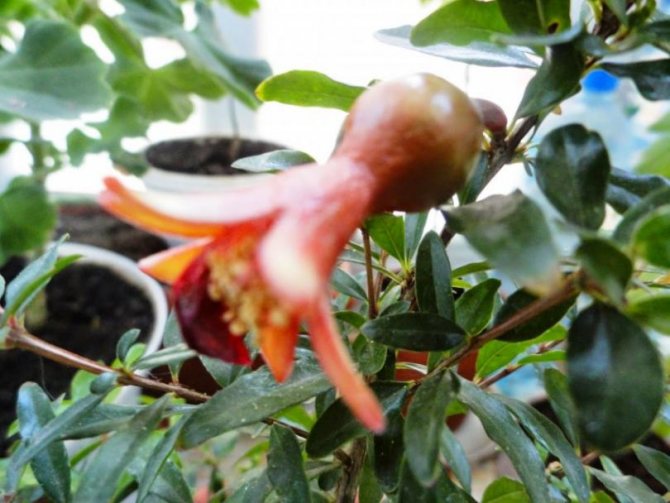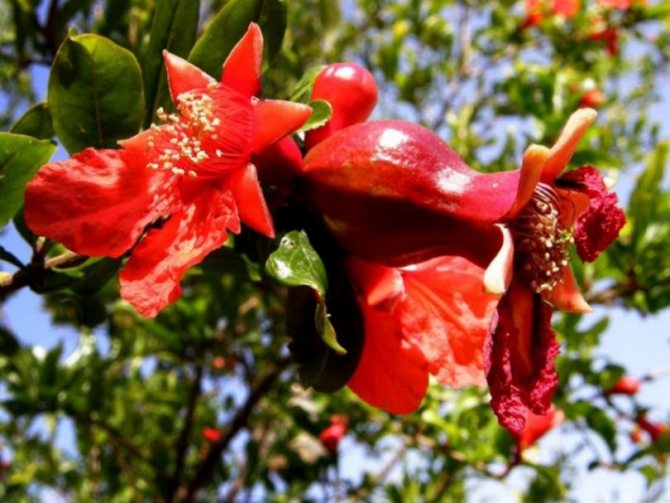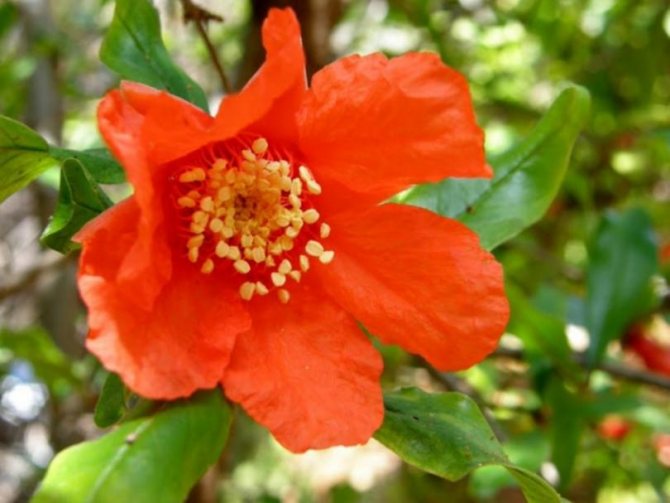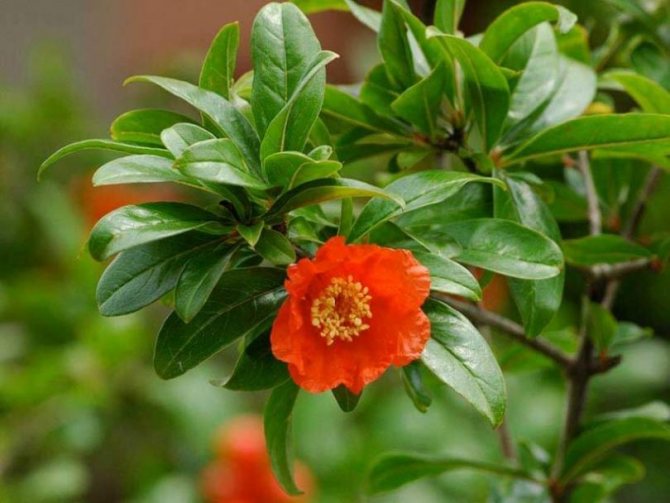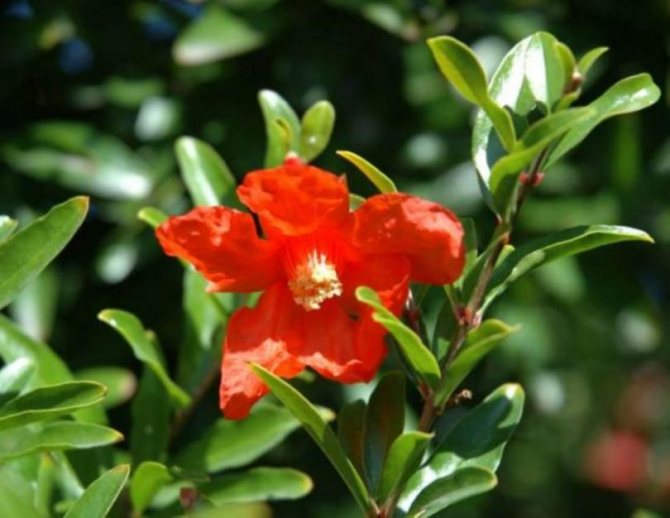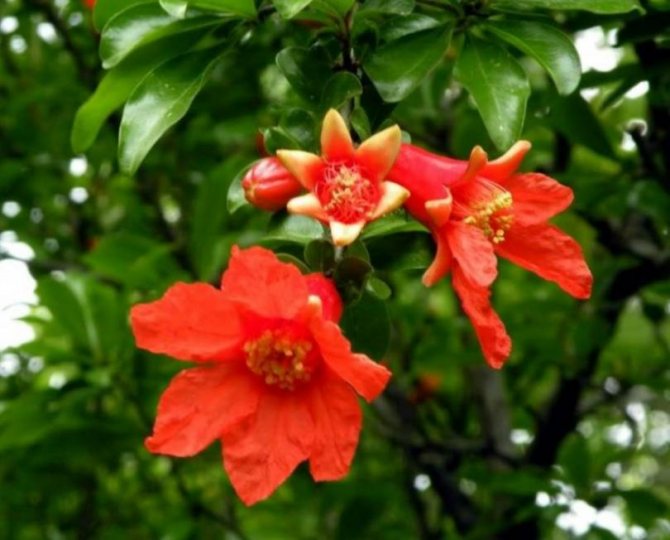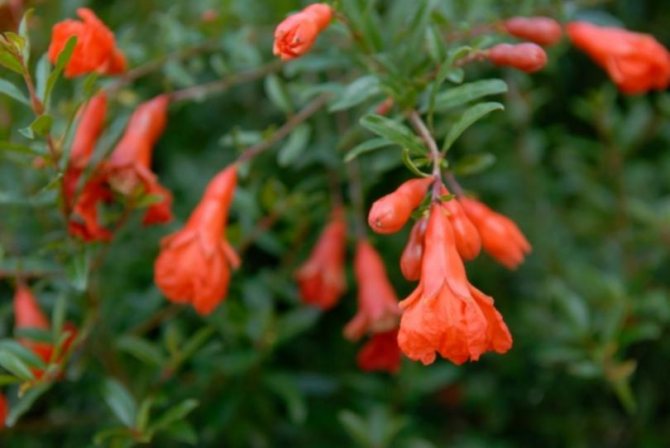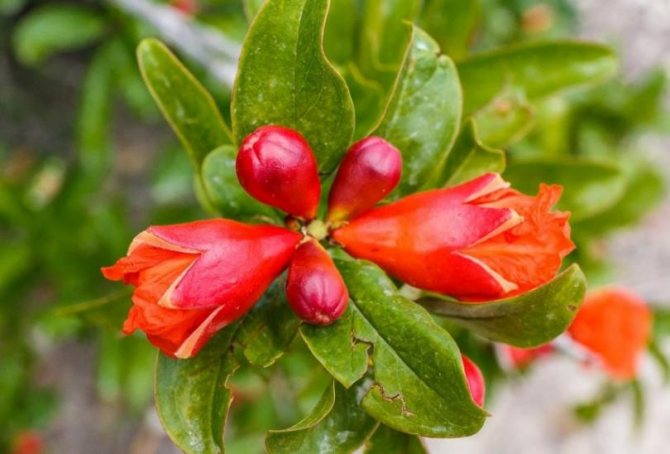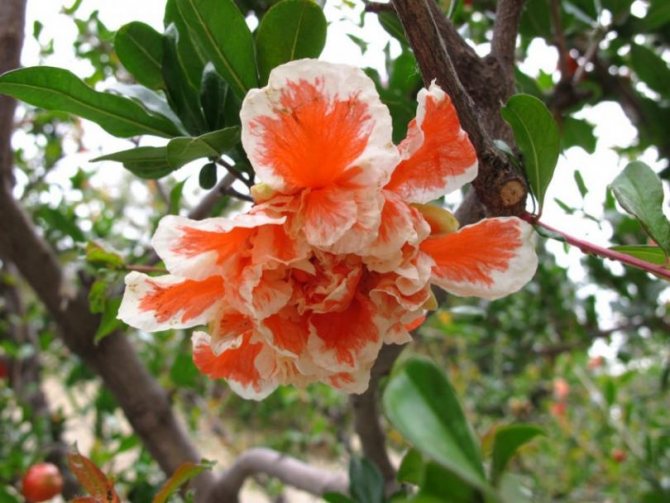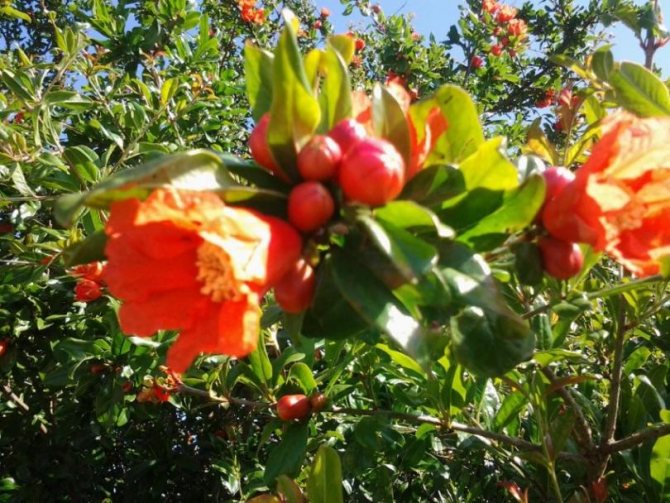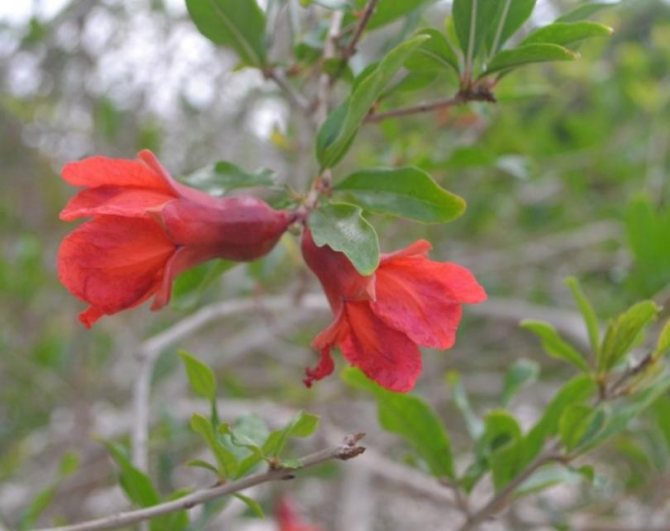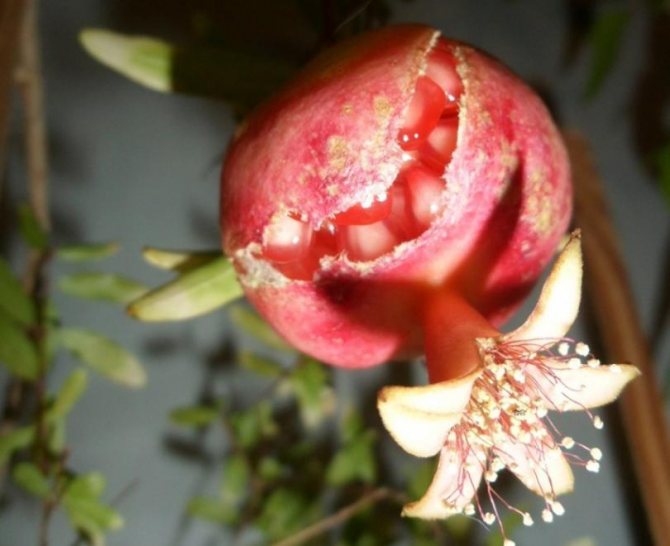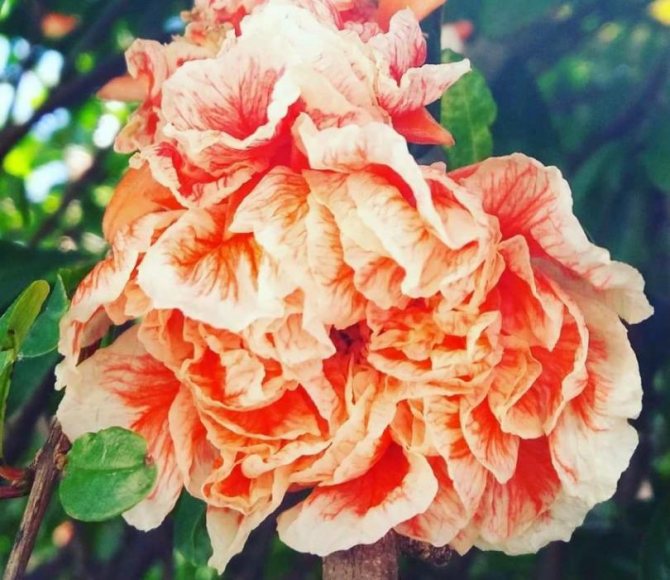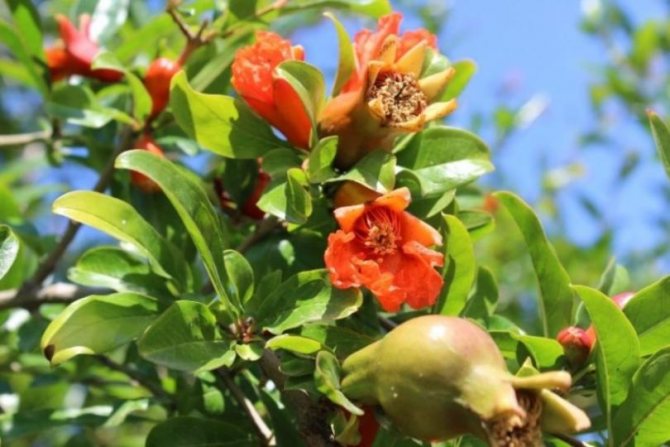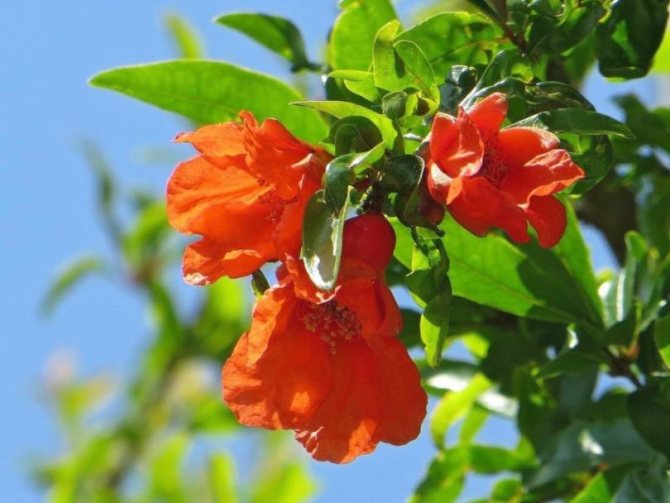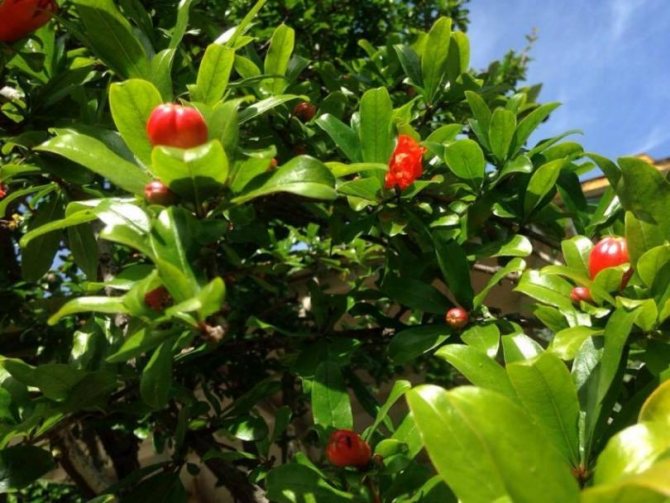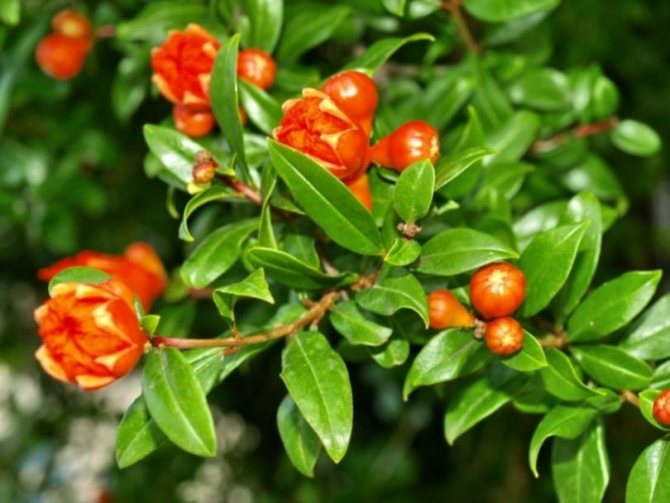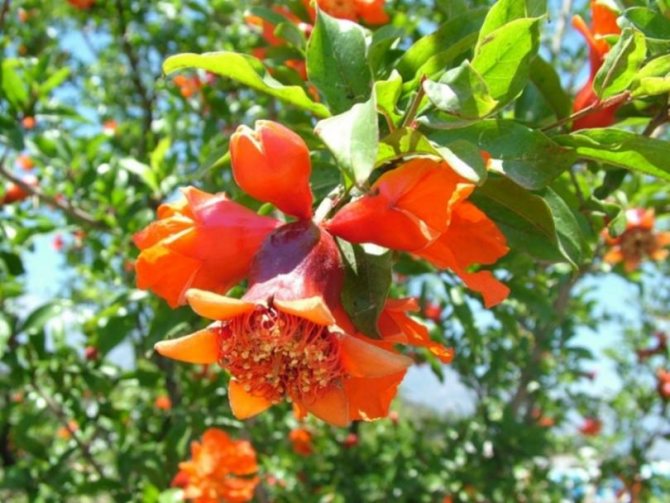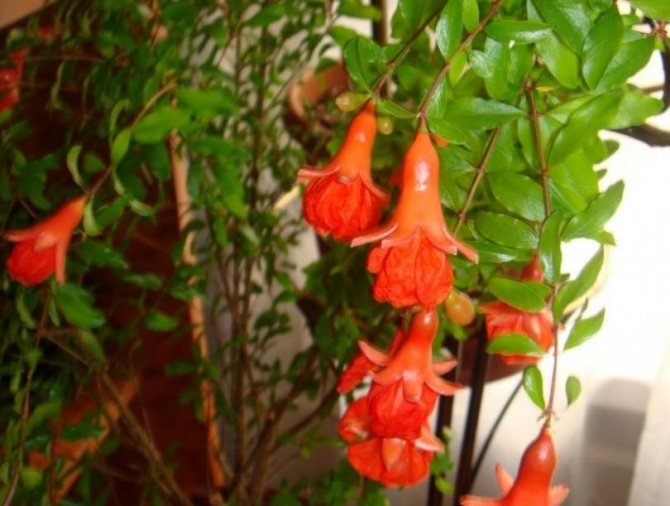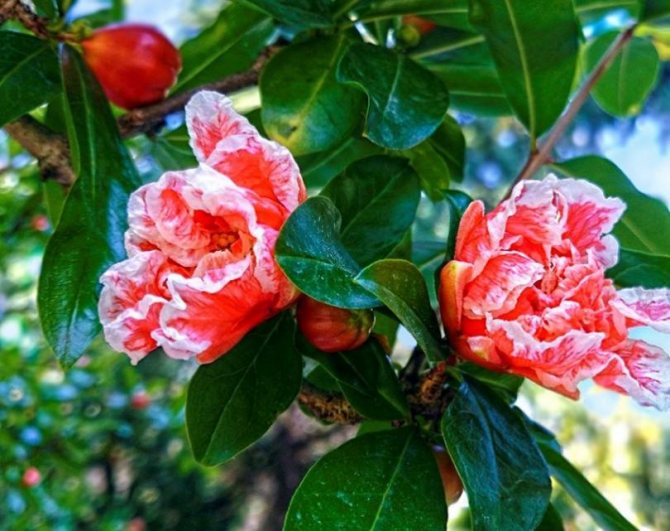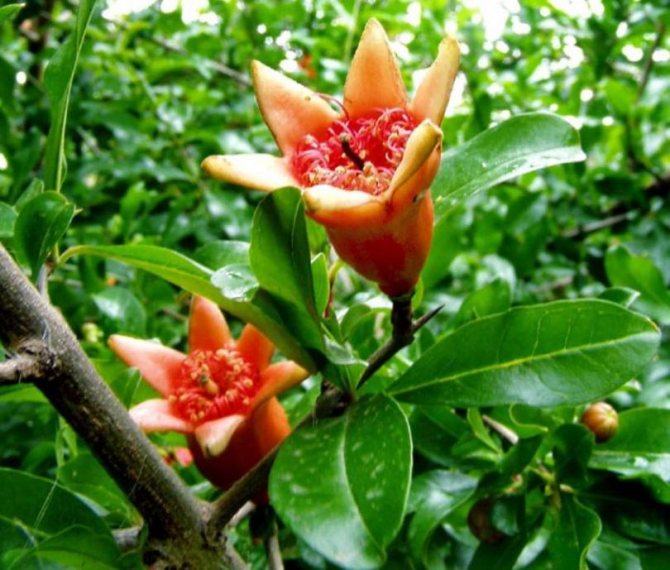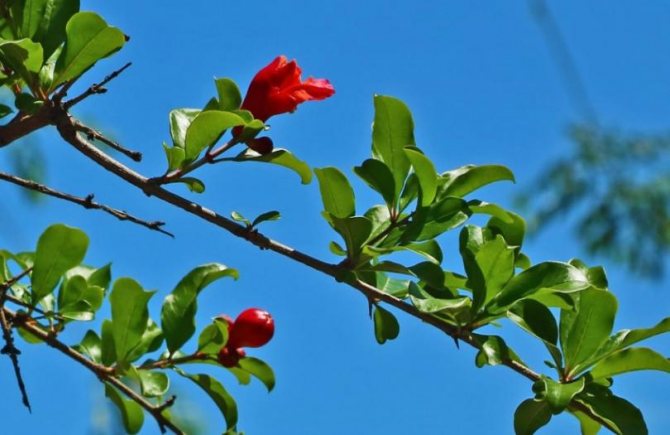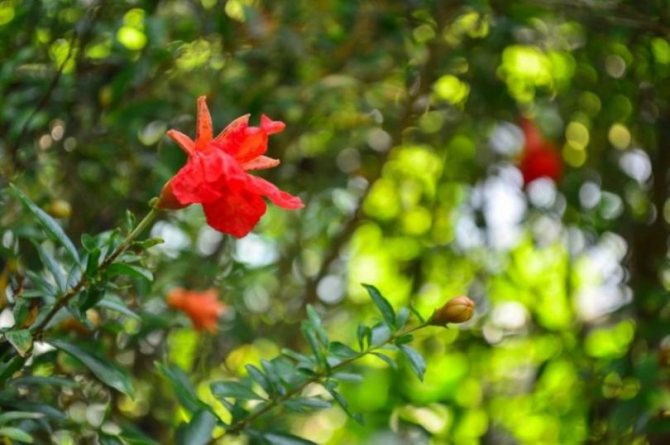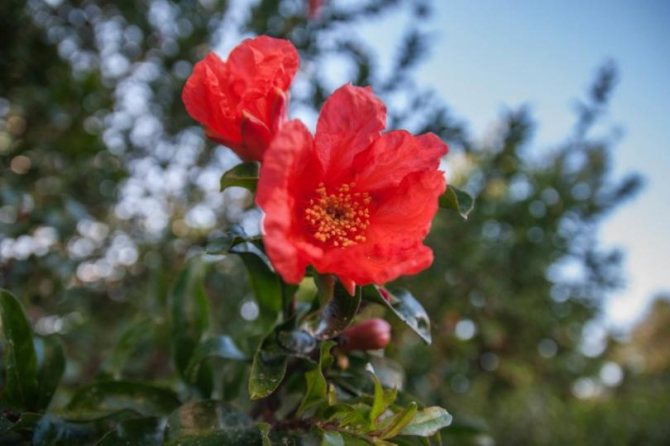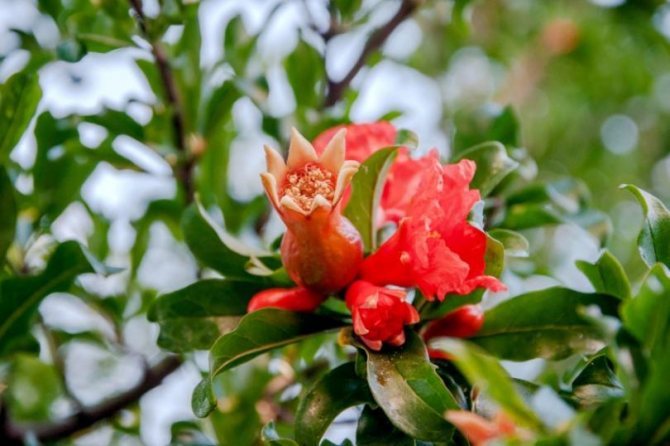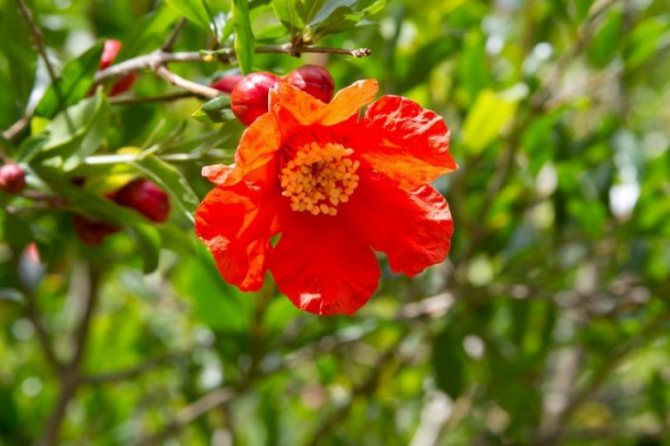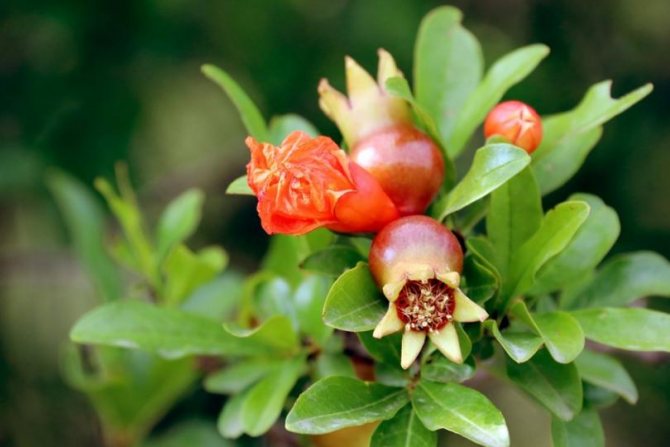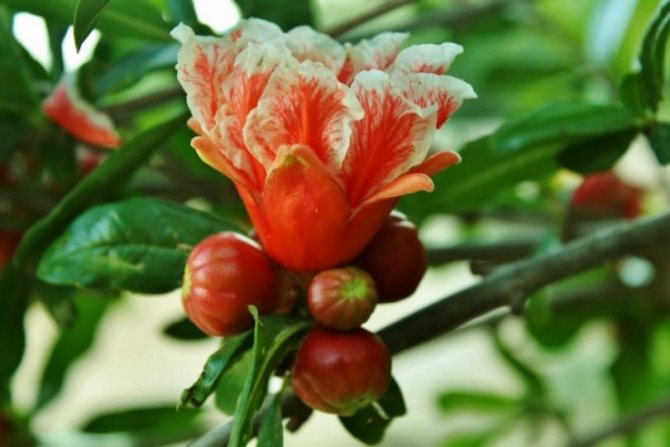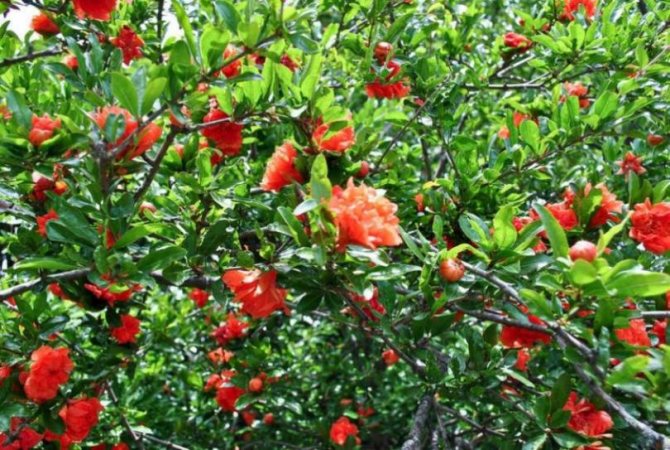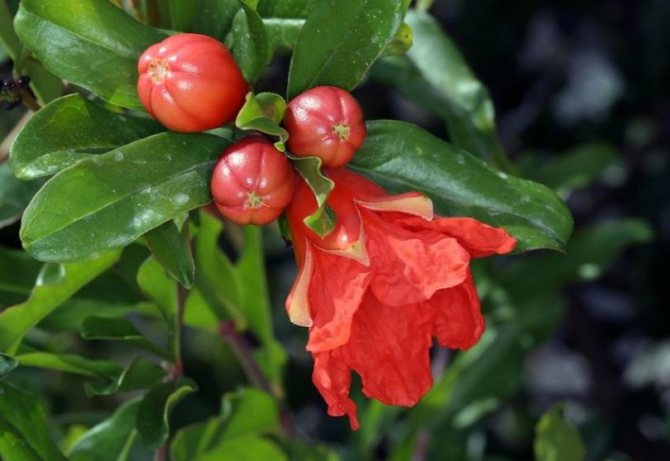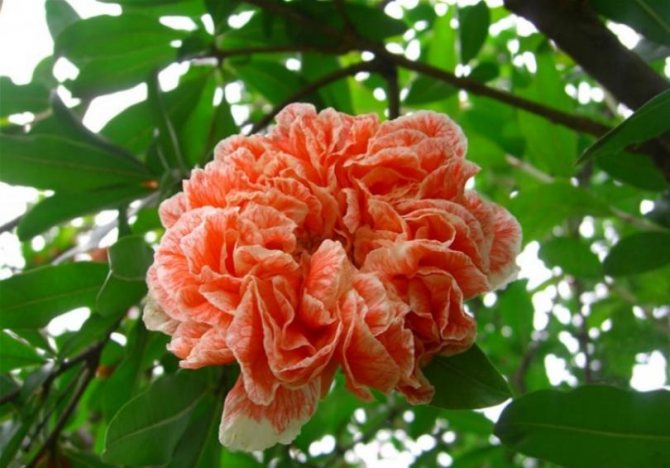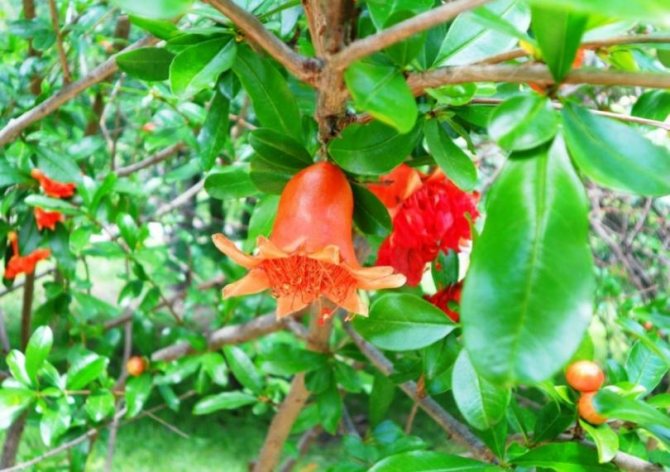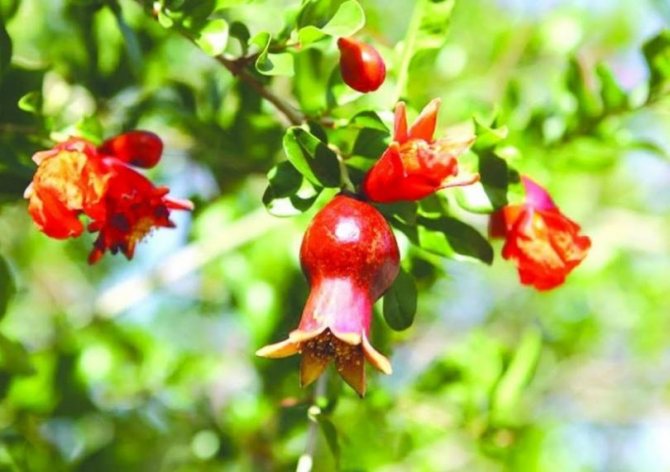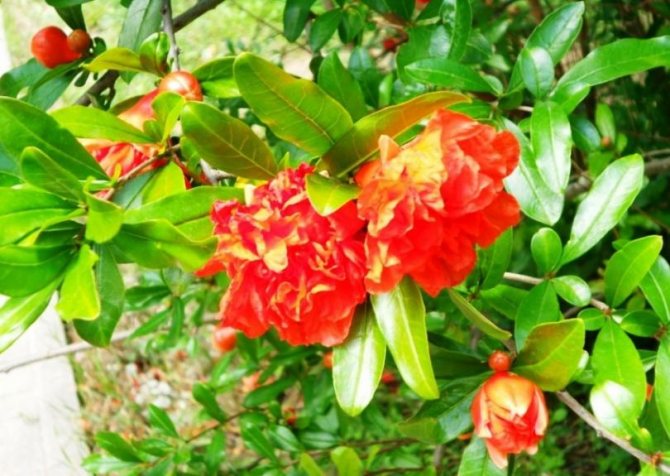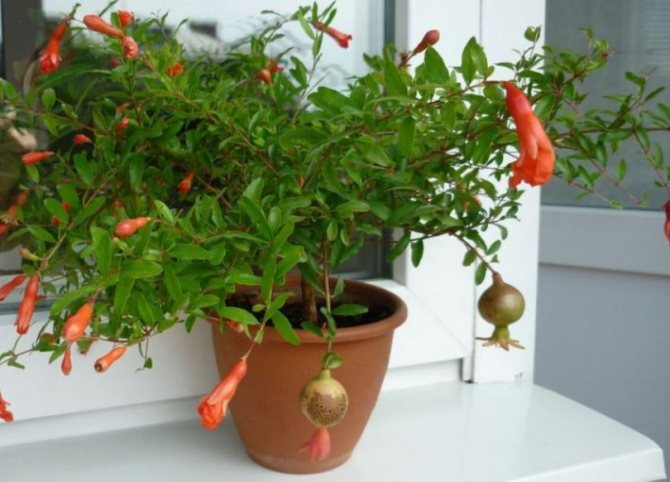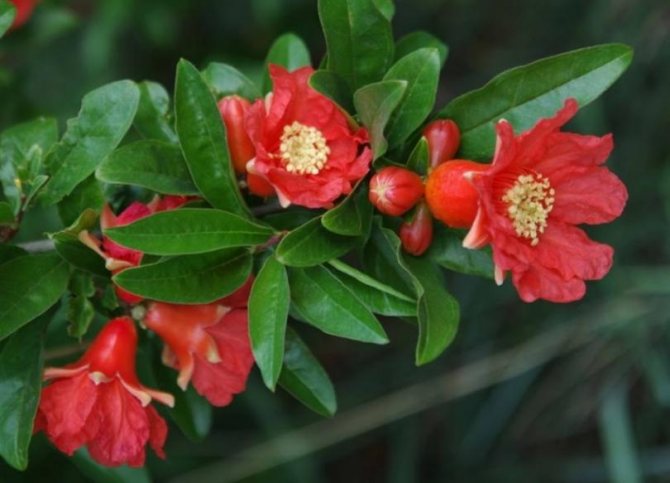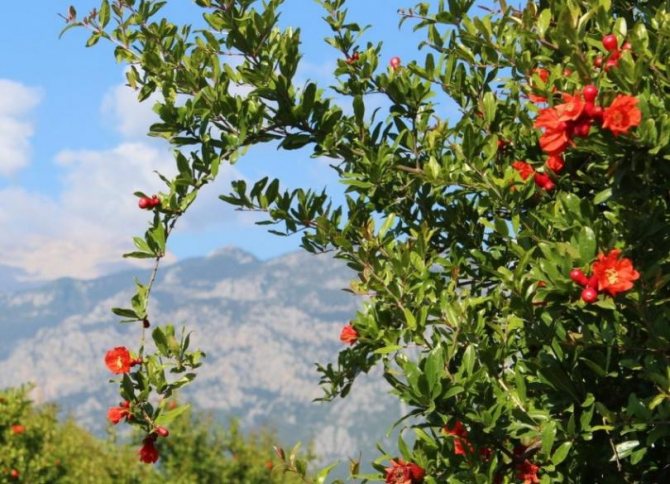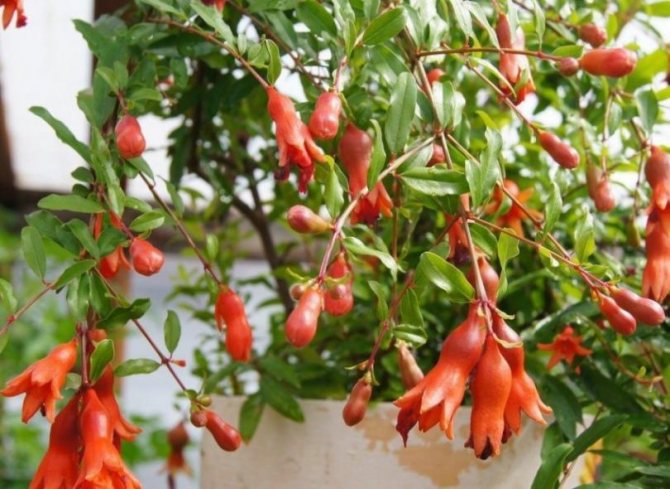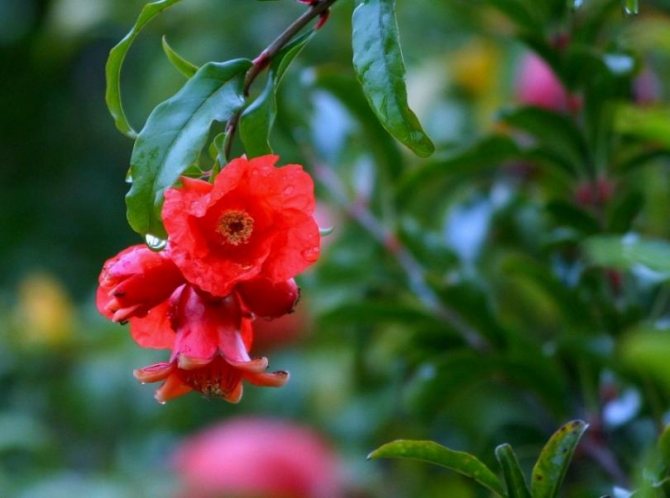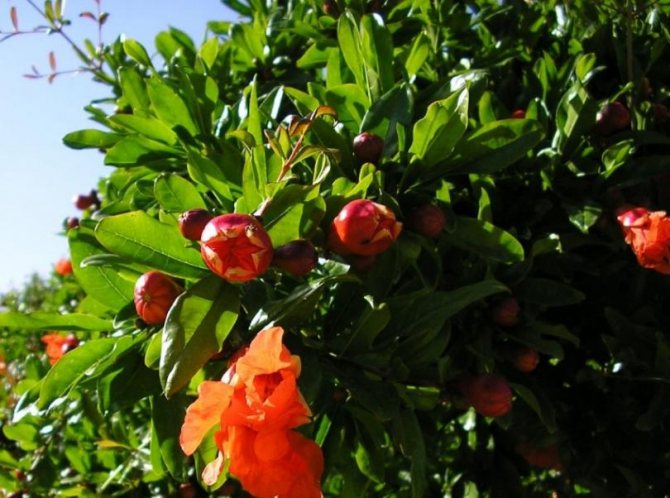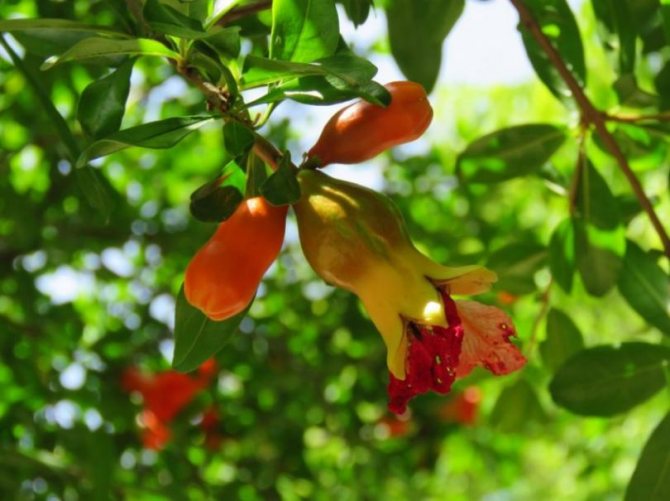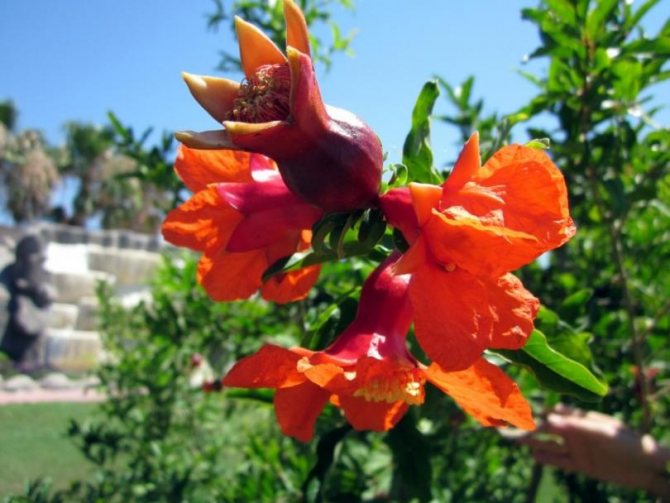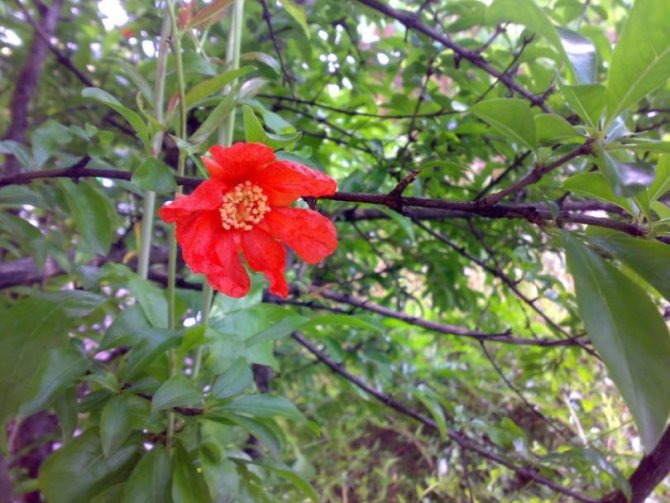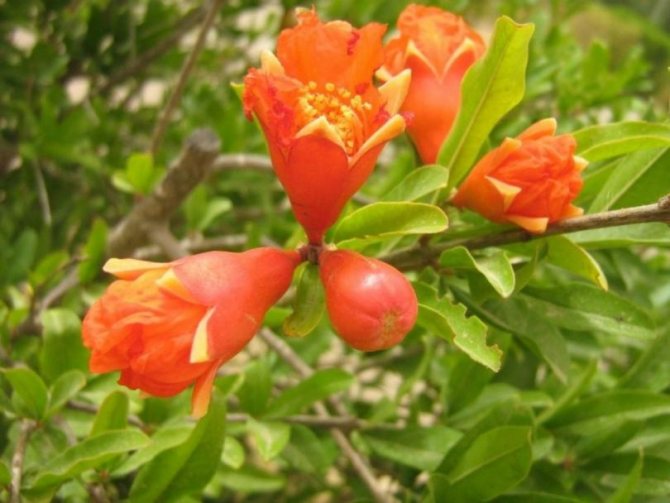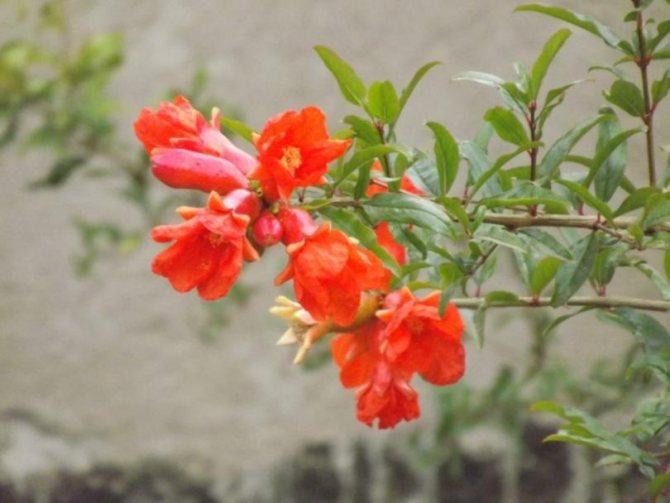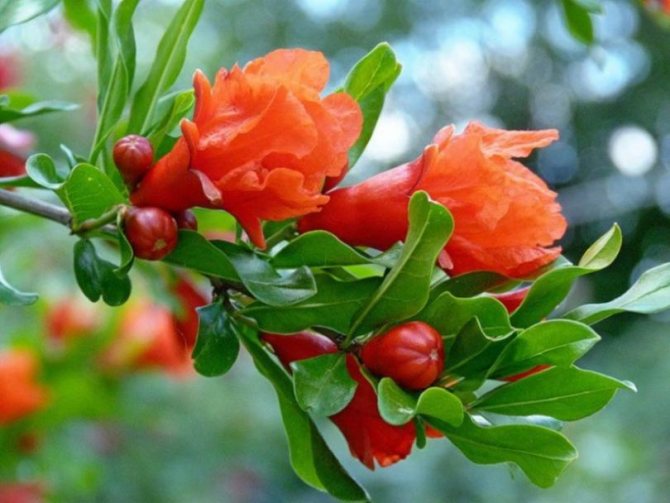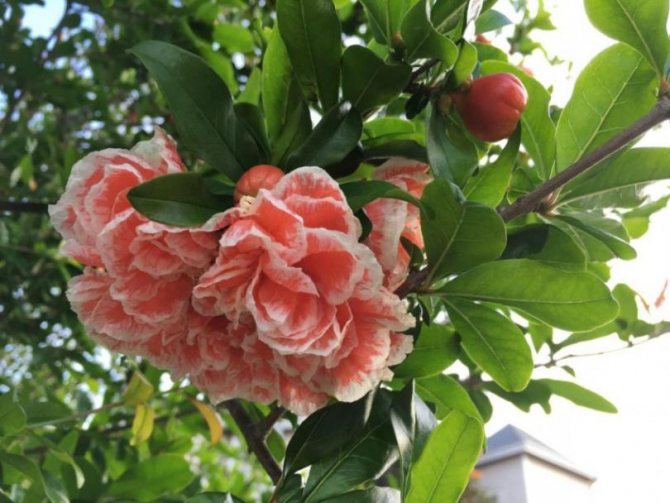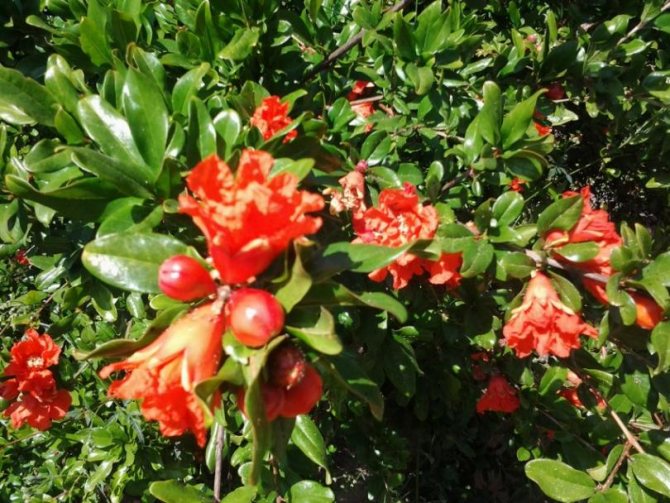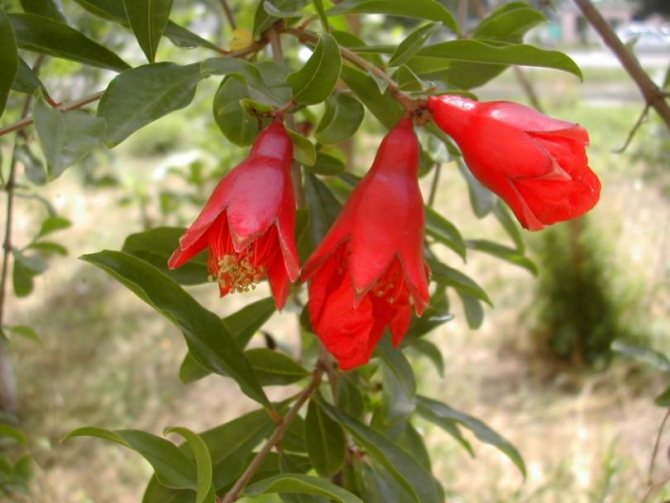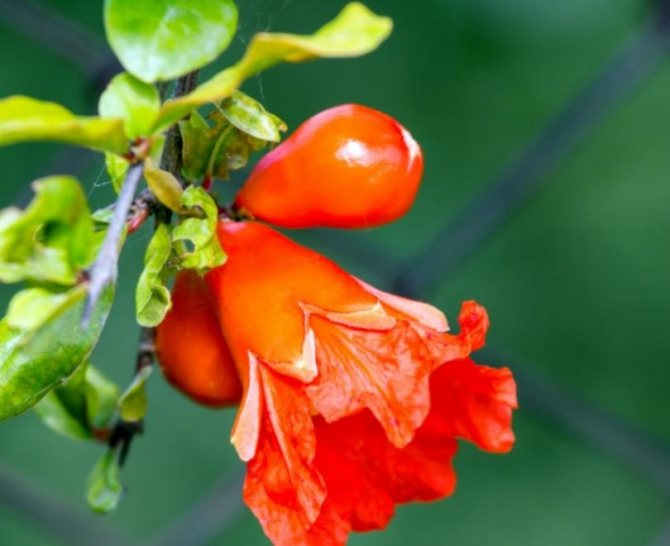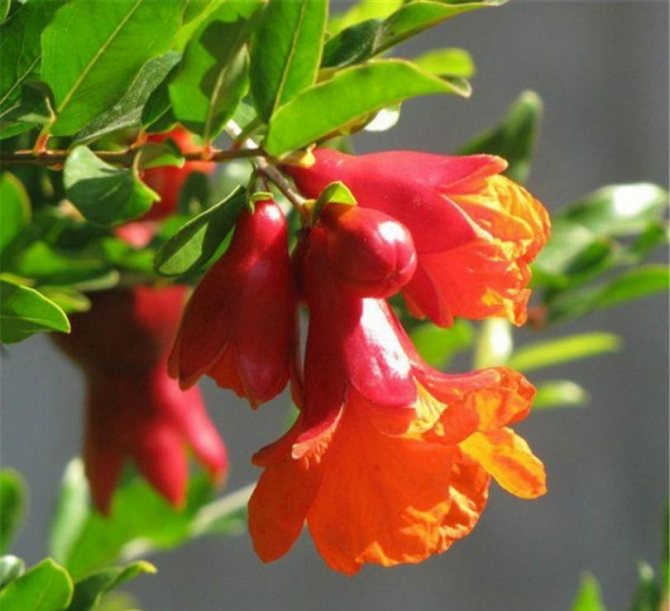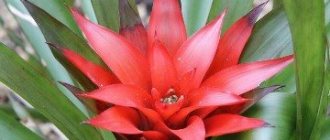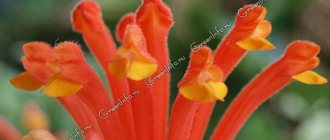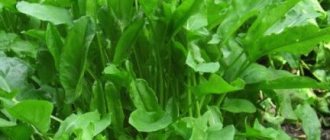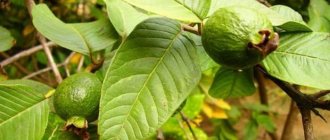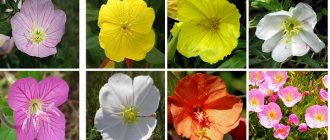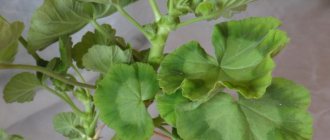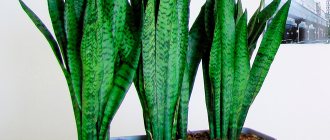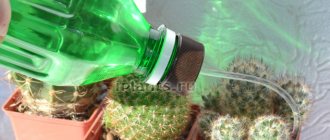Jugs
The flower of the "female" species has a more convex base and in its appearance somewhat resembles a small jug. The edges of the "neck" of the jug are decorated with triangular dense teeth, which turn into a crown on an adult fetus. The pistils of the "female" flower are long enough that they are located at or above the stamens.
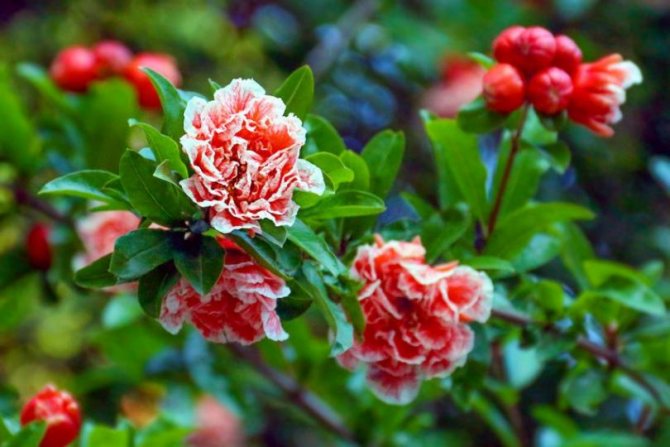
Such inflorescences are not formed on young shoots younger than one year old. The ovary of the bud consists of several nests, which are filled with grains when the fruit ripens.
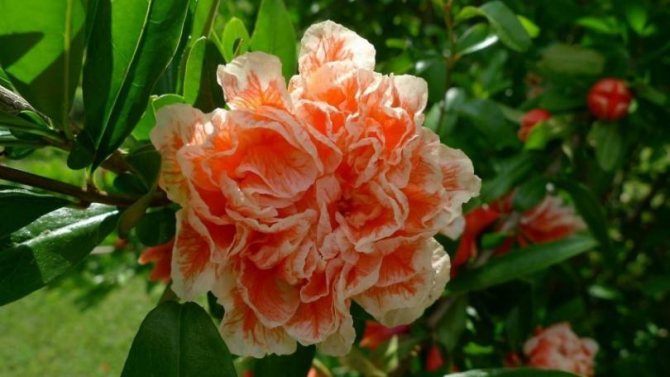

Pruning the plant
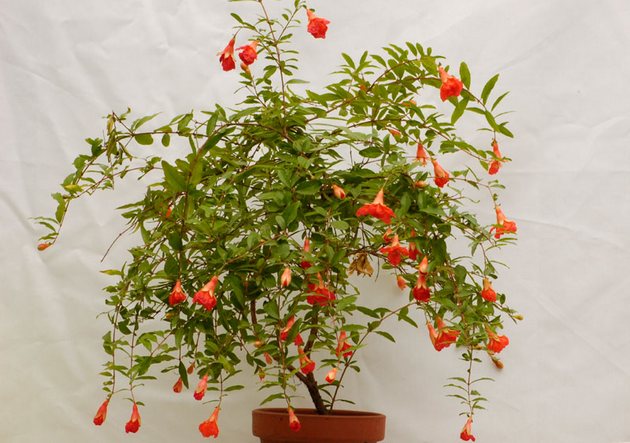

A young pomegranate will acquire a decent look and abundant flowering only if its crown is formed. Pruning should be done in the last days of February. Cutting not only helps the pomegranate to look decent, but also promotes the formation of branching.
Three to five pairs of leaves should remain on the tree after pruning. You need to form pruning focusing on the looking kidney. The shoots that remain after the pruning process are viewed along the looking bud.
The crown is formed at the request of the grower. It can be oval or round. For those who want to try their hand at the art of bansai, pomegranate is ideal. Pomegranate leaves can be shaped in different styles.
There is no need to be afraid of the situation when the owner of the tree will cut off the extra branches. With the beginning of spring, the pomegranate tree will gain strength, and new shoots will grow.
Bells
The buds of "male" inflorescences, in contrast to the "female" ones, have a narrower part at the base and wider at the end. Due to this, they resemble bells in their appearance.
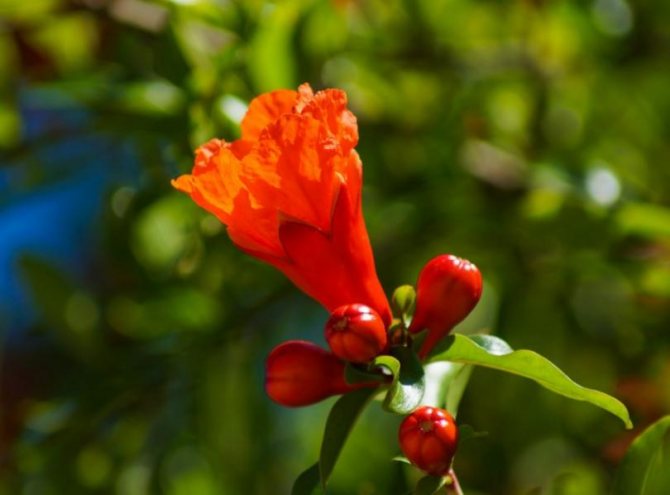

The pistils of these cute bells are short and hidden inside the anthers. Such inflorescences are most often laid on fresh branches of the current year and, after they have faded, they simply fall off the tree.
The ratio of the total number of "male" and "female" inflorescences most often depends on a particular variety. In addition, this point can be influenced by proper care and environmental conditions.
Collection and preparation of seeds for planting
A favorable time for sowing pomegranate seeds, according to the observations of gardeners, are November and February. Seeds sown at these times can sprout in a week, at other times of germination you can wait for more than one month.
It is better to plant closer to spring, the seedlings are stronger, and you do not need to suffer with additional lighting all winter.
Seeds for sowing are taken from a large, ripe fruit without signs of rot and damage. Ripe seeds are hard and smooth, the seeds are white or creamy. If the color is green and the seeds are soft to the touch, then they are not suitable for planting.
For planting, choose hard and smooth seeds.
When buying ready-made seeds, be sure to check the expiration date, weight of seeds, company logo, variety. All this should be indicated on the packaging. It is better to make a purchase in a specialty store, rather than in the market with strangers.
Seed preparation for planting:
- The seeds are cleaned of pulp and washed well with water. To properly cleanse the pulp to prevent rot later, the bones are rubbed with a paper towel.
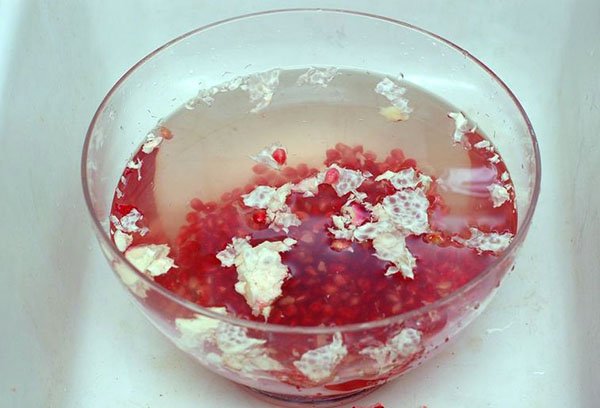

Seeds must be washed with water and thoroughly peeled from the pulp.
- Then they are soaked in a small amount of water on a saucer with the addition of two or three drops of Epin or Zircon to stimulate germination. The seeds should be half-covered with water and left that way for 12 hours. Water must be added as it evaporates, preventing the seeds from drying out.
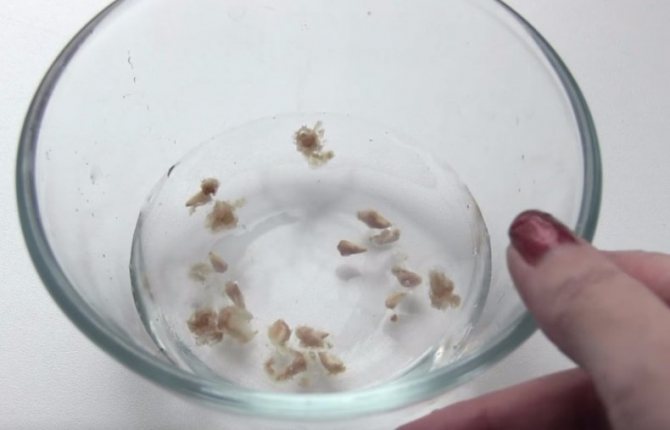

Water is added as it evaporates
- The container is placed in a cool place without drafts.
Color spectrum
The color palette of a plant such as pomegranate is varied only in scarlet, crimson, pink and white shades. There are varieties of variegated inflorescences.
The shape of the flower is so unusual and graceful that at first glance it is impossible to understand what kind of plant it is.
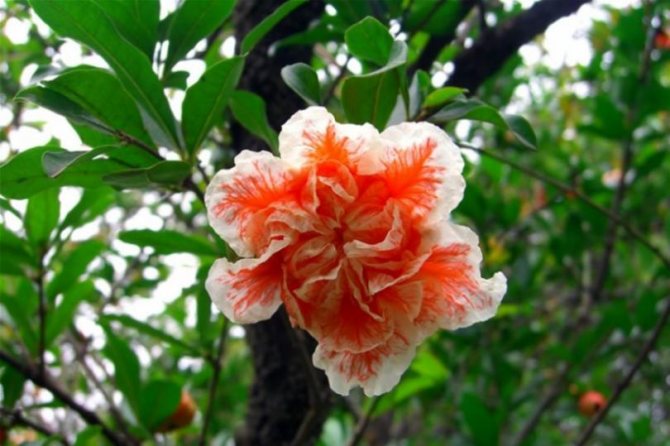

Planting instructions
To sow pomegranate seeds at home, you need to follow these steps:
- Prepare the soil. It can be anything, the main condition is looseness, moisture and air permeability, preferably slightly acidic or neutral (pH from 6.0 to 7.0). But this does not mean that the pomegranate will not be able to take root on other soils, in natural conditions it grows both on clay and on sand. From ready-made soils, the best choice is for roses or begonias. Recommended mix in equal parts:
- humus;
- sod land;
- leafy land;
- river sand.
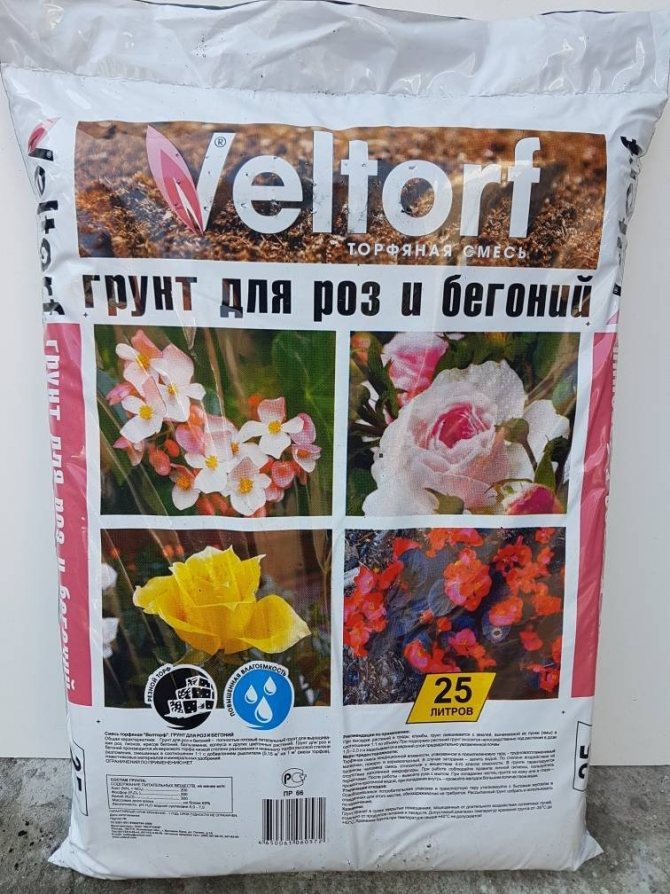

For growing pomegranates, ready-made soil for roses or begonias may be suitable.
- Prepare the sowing container. This can be a plastic container, a wooden flower box, or a flower pot. Sowing dishes are chosen shallow, since the root system of the pomegranate grows in breadth. The size of the container depends on the number of seeds to be sown, taking into account a certain distance between them (about 2 cm).
- Place a drainage layer on the bottom. As drainage, you can use:
- expanded clay;
- small pebbles;
- broken brick;
- shards of ceramic pots.
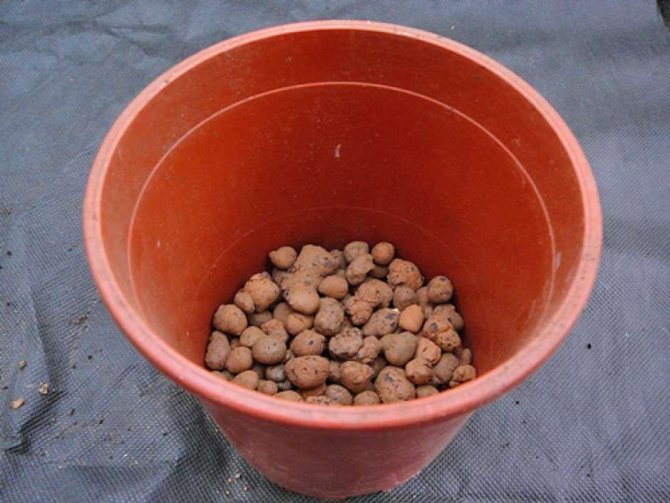

Expanded clay is best used as drainage.
- Fill the container with soil and pour clean water over the top.
- Spread the seeds evenly over the surface and bury them neatly into the ground by 1–1.5 cm. The soil from above should be loose, there is no need to compact it.
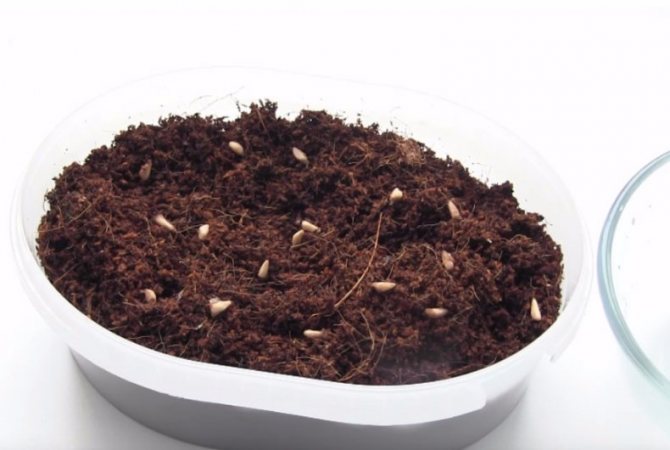

The soil must be loose
- Close the container with a lid or foil to create a greenhouse effect, put it in a warm, bright place.
Video: preparing and sowing pomegranate seeds
Pomegranate flowering time
A plant grown from a seed usually blooms after 3-4 years, for a pomegranate grown from a cuttings - 2-3 years. Sometimes an abnormally early flowering of pomegranates occurs, usually in this case only a few buds bloom and subsequently fall off.
Pomegranate, when grown at home, has two flowering periods. The first bloom occurs in April-May, the second in August. Despite the fact that one bud fades in 3-4 days, it is immediately replaced by another bud, and this continues until the end of the entire period.
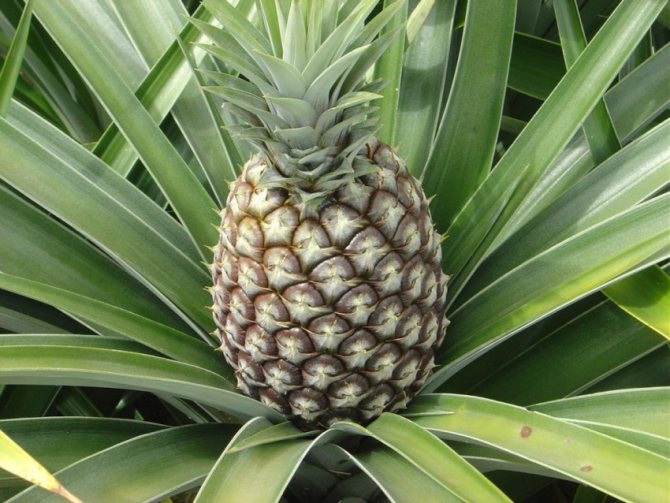

How to plant pineapple from the top: care tips, maintenance rules and features of growing at home (135 photos + video)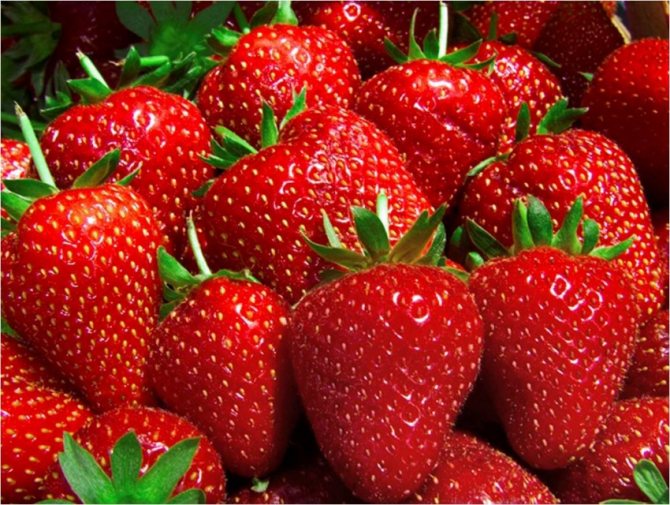

What is the difference between strawberries and strawberries - 120 photos, videos and comparison of garden and forest species. Description of differences and detailed analysis of features
- How to grow a cherry from a stone - tips how to grow it quickly and easily at home. Features of the care and maintenance of cherries (105 photos)
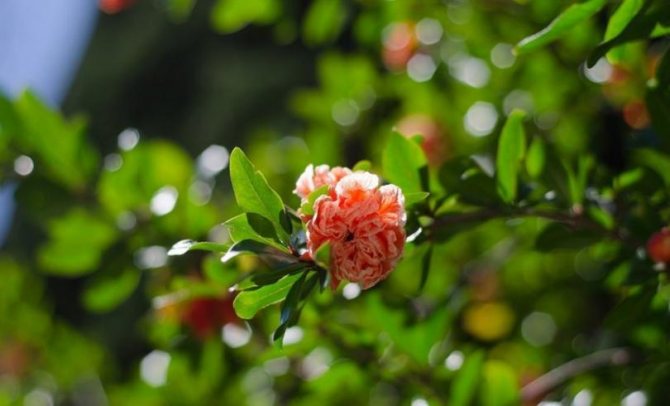

Until the fall, the plant shines with flowers, like garlands. It is especially interesting to observe that the buds are laid, flowering and fruiting - at such moments the pomegranate looks very luxurious and fabulous.
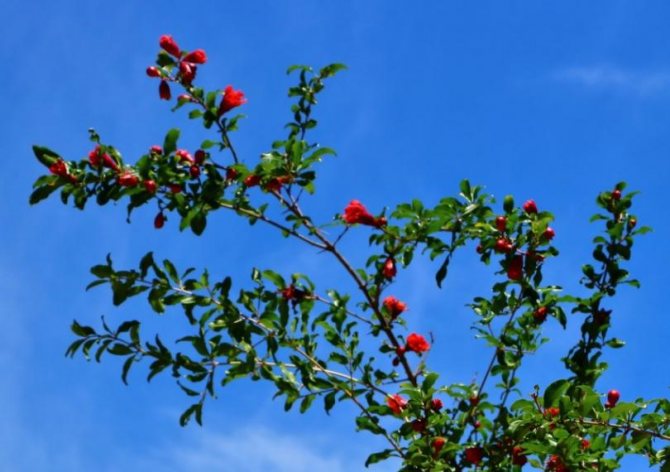

Conditions for growing pomegranate in the open field
The conditions for growing pomegranate are not entirely simple, so the culture is common only in the southern regions. Pomegranate, despite its subtropical nature, successfully conquers new territories.Having picked up the appropriate variety, early ripening, tasty and productive, everyone in their garden can grow this tree, which can bring about 50 kg of tasty fruits. Growing pomegranates in the open field is possible only using a covering method. For the winter, they bend the tree to the ground, tie the branches to the hammered stakes and cover it with a 10 cm layer of soil. In this form, pomegranates can withstand temperatures down to -30C and bear fruit perfectly. You can provide him with a frame - film shelter. In an uncovered state, pomegranate grows only in summer. Grow the pomegranate in a sunny place protected from the cold wind. To obtain a bountiful harvest and high-quality fruits, water the pomegranate sparingly in the near-stem circle, controlling watering, with excessive watering, the fruits may crack. After watering, loosen the soil, avoiding the formation of a crust. During the ripening period, the pomegranate needs dry air and warmth.
In the open field it can withstand temperatures down to –12–14 ° С.
Natural drop of flowers
As we already understood, the fall of pomegranate buds during flowering is normal. In this regard, the plant itself determines how many flowers it will withstand, so that in the future it does not deplete itself at all. This is a natural process not only for the common pomegranate that grows outdoors, but also for a similar indoor plant such as the dwarf pomegranate.
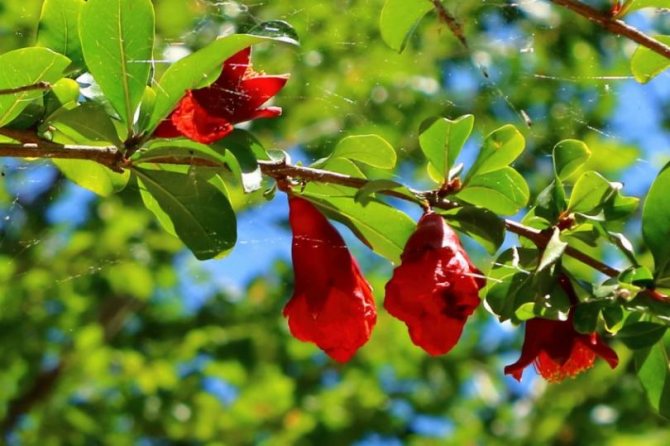

Whatever the variety, if the tree bears fruit, then the fall of the inflorescences is inevitable. And let us remind you that mostly “male” specimens fall - barren flowers.
Growing basics
After growing out of a small stone, pomegranate is unpretentious. However, there are special recommendations that allow it to bloom and not allow it to dry out.
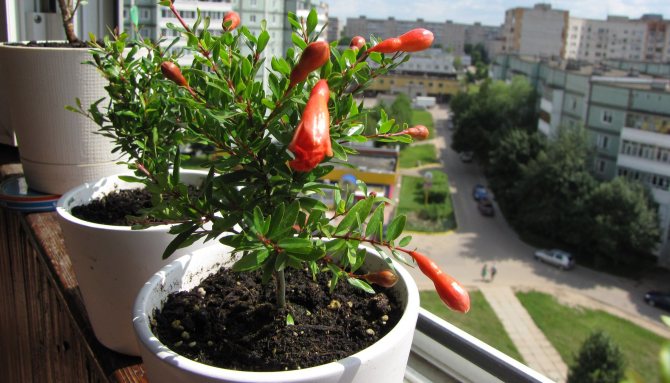

The basic rules for caring for a grown tree include:
- In the warm season, you should adhere to the temperature regime within 18-25 degrees. In winter, you need to keep the plant in a room with a low temperature, which should be from 12-15 degrees. In the spring, after the last frost has passed, it is allowed to transfer the plant to the balcony or yard.
- Compliance with the rules of watering. In the summer, watering the plants is carried out often, as the earthen clod dries up. In winter, it is recommended to reduce the number of spraying of the planting soil. Watering is carried out only in the upper part of the plant, since the pomegranate has a superficial root system.
- Top dressing for fruiting. In order for the pomegranate to regularly bear fruit, it must be fed with universal fertilizers. With proper feeding, once every two weeks, fruits will appear frequently. However, if the owner of the pomegranate tree wants to eat fruit, then it is forbidden to use top dressing. Since they contain nitrates, you cannot eat foods after regular feeding.
- Dropping leaves from a pomegranate tree is a normal process. Many growers in the winter keep the tree in a warm place on purpose so that the leaves remain on the plant, but this is wrong. In the future, the depletion of the plant and a slowdown in its growth will be observed.
- Swelling of the kidneys is observed in mid-February. The plant during this period must be transferred to a warm place. Watering needs to be increased. Weak and dry shoots must be cut off so that they do not interfere with the further growth of the plant. In the future, the bush will be covered with new leaves.
- It is recommended to transplant the plant at least once a year. The pot should be taken 2 centimeters larger than the previous one. A pomegranate tree more than three years old is transplanted if its roots fill the entire clod of earth. This tree is comfortable in cramped pots. In them, it blooms profusely and continues to grow rapidly.
Diseases and pests
Stronger than natural color fall of pomegranate buds is usually a sign of plant disease.
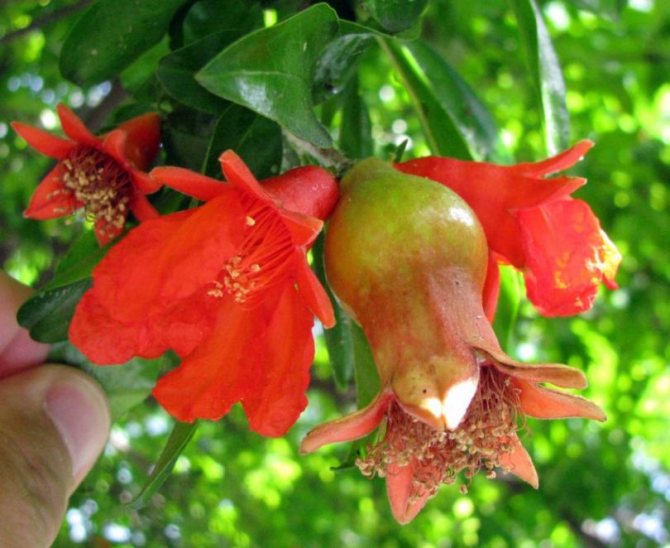

The appearance of a white bloom on pomegranate leaves is a sign of powdery mildew damage.Treatment can be carried out using Fundazole.
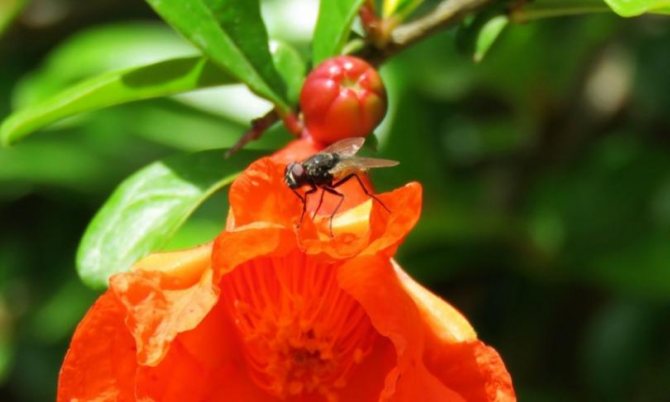

- Peaches benefits and harms to human health: expert advice, a review of the composition and recommendations for use (100 photos)
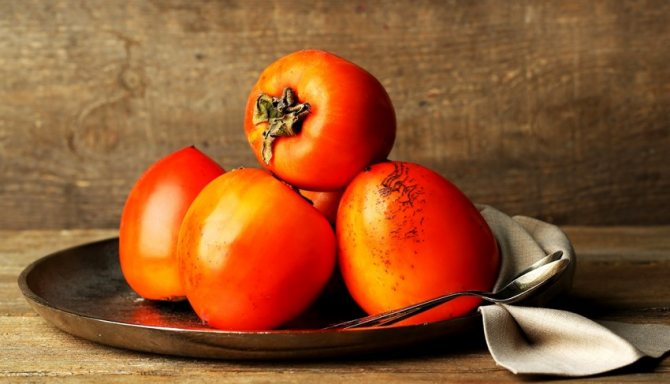

How persimmon grows: a detailed description of the fruit and video instructions for growing and caring for at home + 125 photos
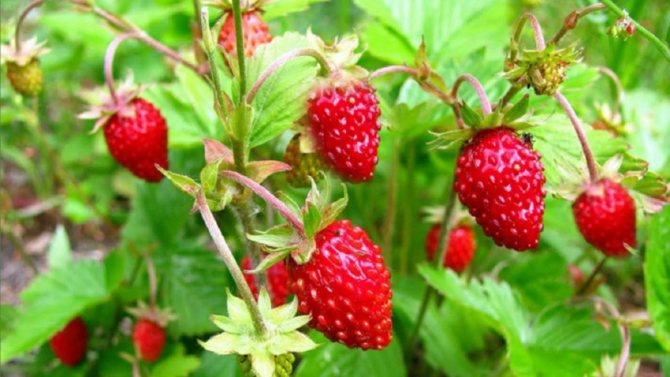

When strawberries ripen: timing and approximate ripening dates. Useful information on picking and growing berries (85 photos and videos)
With gray rot (this disease is dangerous not only by the fall of flowers, but also by the drying of the shoots), the antimicrobial fungicide Topsin M.
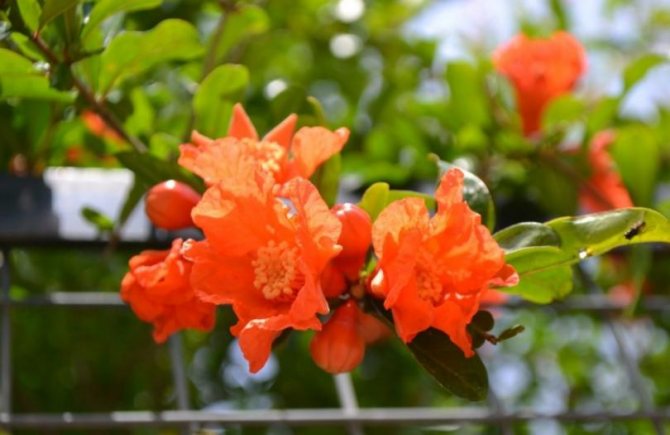

With the death of the main branches, ringing of the base of the shoots, with cracking of the bark and general weakening of the plant, one can diagnose the defeat of the pomegranate by phomosis. With this disease, "female" inflorescences become sterile. You can treat it with Horus fungicide.
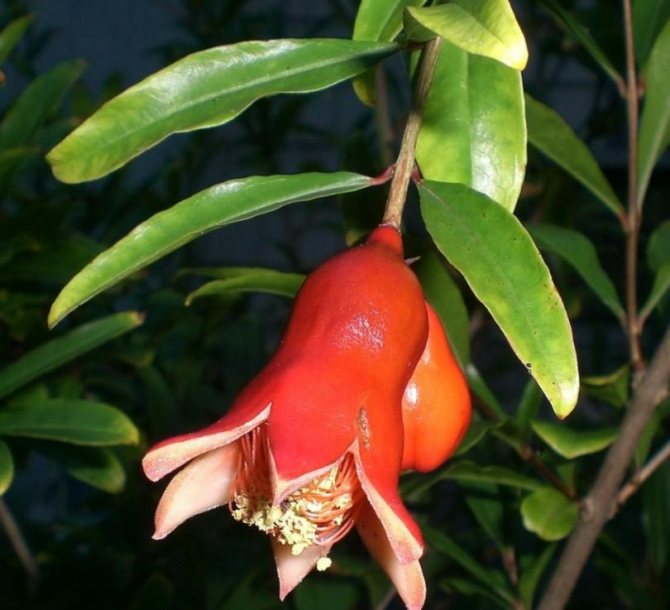

In addition to common diseases, a plant such as pomegranate very often suffers from insects.
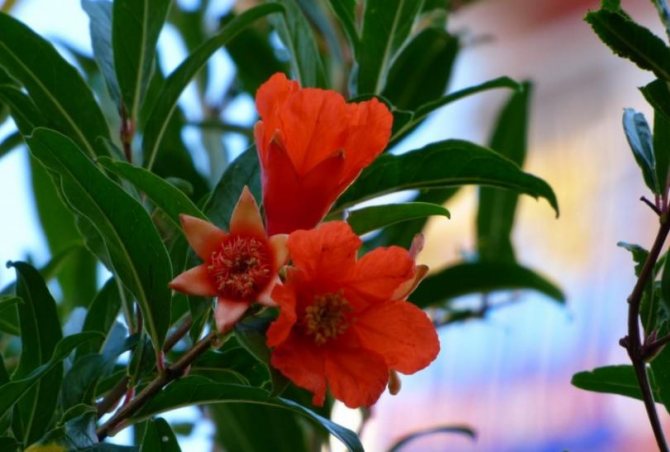

Whiteflies are very fond of infecting leaves, they greedily attack them and suck out the juice. Insecticide Derris helps to kill this insect.
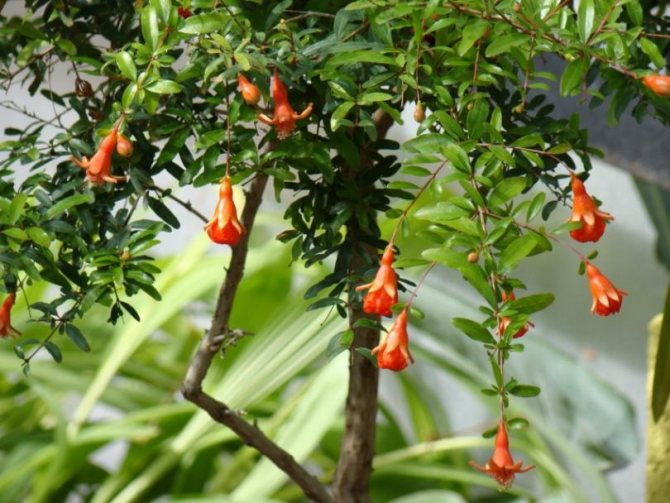

The pomegranate moth fire eats the juicy pulp of ovaries, inflorescences and fruits. This parasite is fought with the use of Intra-Vir and Fitoverm.
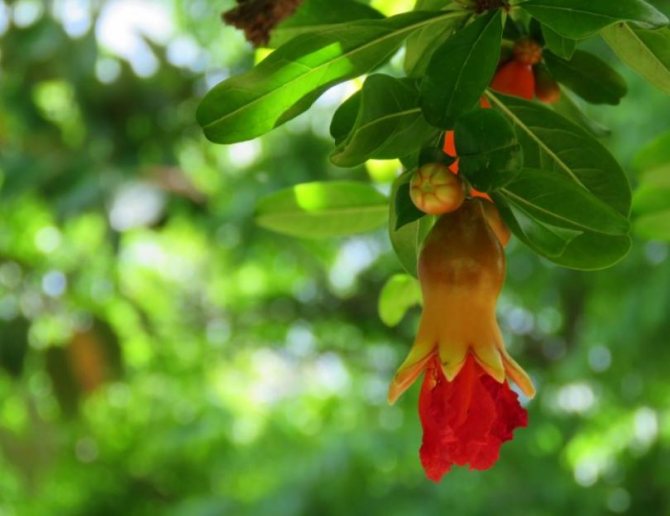

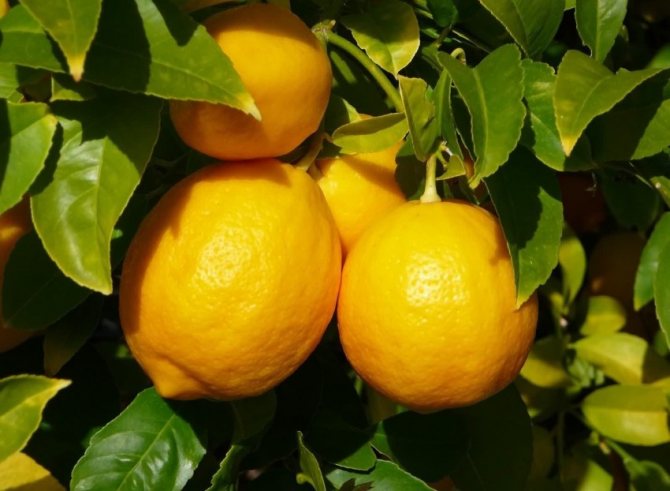

How to grow a lemon from a seed at home - a detailed description of planting and tips for care. Video instruction for growing + 100 photos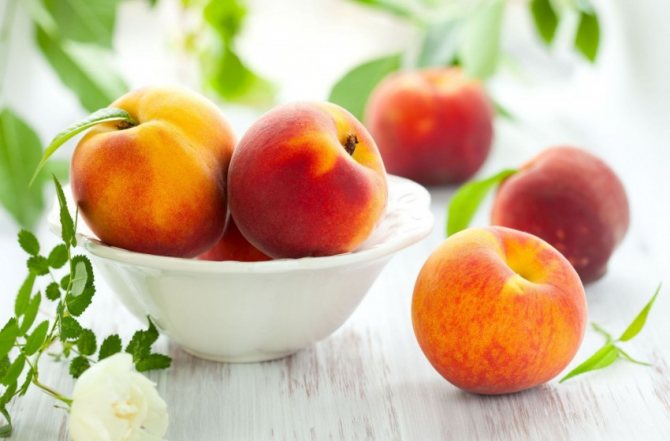

What a peach looks like - a description of the appearance, characteristics and properties of the fruit. Useful tips for choosing, growing and caring for peaches (110 photos)
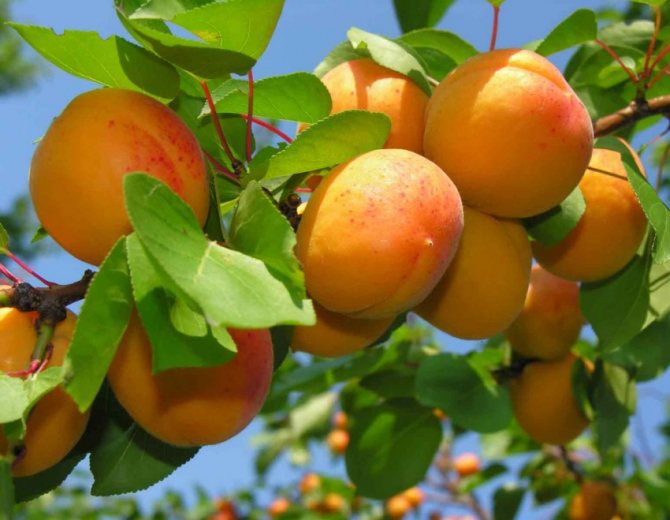

Why apricots are useful - useful properties, composition, health benefits and contraindications for use. 75 photos of apricot
Forming and cutting a pomegranate (with video)
One of the main links in the cultivation technology is the pruning of pomegranates and the formation of bushes, further regulation of growth and development.
The pomegranate can be formed into a single-barreled bush or with multiple barrels. The bush-like form meets the biological characteristics of the pomegranate most fully. In this case, the productivity of the plant is higher and it is more durable.
The bush begins to form with the release of the strongest, well-developed 3 - 4 shoots, and the remaining shoots are cut into a ring. On each shoot, 4 - 5 branches of the first order are sequentially formed, on them - 4 - 5 branches of the second order, then the third and fourth orders. Flowers and fruits are formed on the branches of the last branching order.
Pruning also provides for the thinning of the shoots that thicken the crown and for the shortening of the main shoots. It should promote the formation of strong skeletal and semi-skeletal branches.
Fatty, strongly growing shoots should be cut out immediately after their appearance, it is also necessary to promptly remove root shoots, which often and in abundance appear in the bush. Shoots extending beyond the crown and weakly growing branches are shortened. Watch the pomegranate trimming video showing the whole process:
With a decrease in yield, drying out of individual shoots and branches, it is necessary to apply partial rejuvenation of the crown. For this, drying out and weakened shoots are removed. Instead, several shoots appear, of which 1 - 2 are left, and then they are formed, as was done at the beginning. Due to the high shoot-forming ability of the pomegranate, the aerial part of the plant is quickly restored. When the standard is formed, cut and form in the same way as the feijoa plant.
Before the beginning of the dormant period, which is signaled by partial leaf fall, it is recommended to cut off the branches by a third and pluck out the remaining leaves (but only if a cool wintering is provided for the pomegranate).
Improper care
In addition to diseases and pests, pomegranate blooms often suffer from improper care.
Illiterate watering. This plant does not always need normal watering.Very often, during the flowering period, gardeners do not water it. But if you do not understand the essence of the matter, you can simply destroy the plant, which will not only begin a massive decline in flowers. The leaves will begin to wither and the tree will wither.
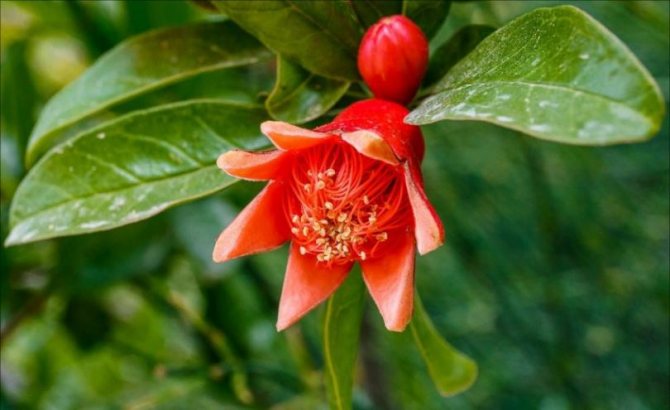

Spring frosts are also dangerous both for the tree and for future inflorescences. If the pomegranate survives after such a nuisance, its flowering will either be postponed to the next year, or it will be belated and not abundant.
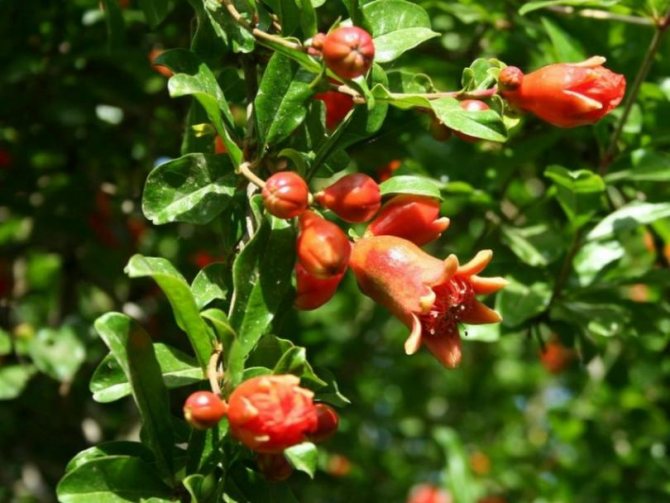

Insufficient lighting. Of course, the tree will grow in the shade, but without flowering, since it needs an eight-hour period of sunlight per day.
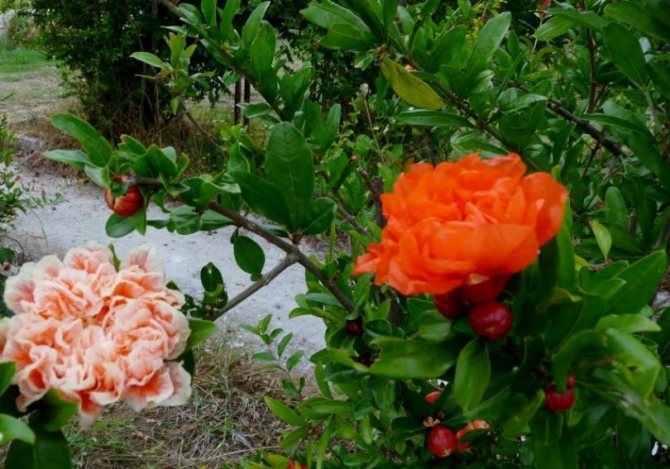

Incorrect pruning of the tree. The formation of the crown of the pomegranate must be done in late February - early March, when the plant has not really woken up and there are no green shoots.
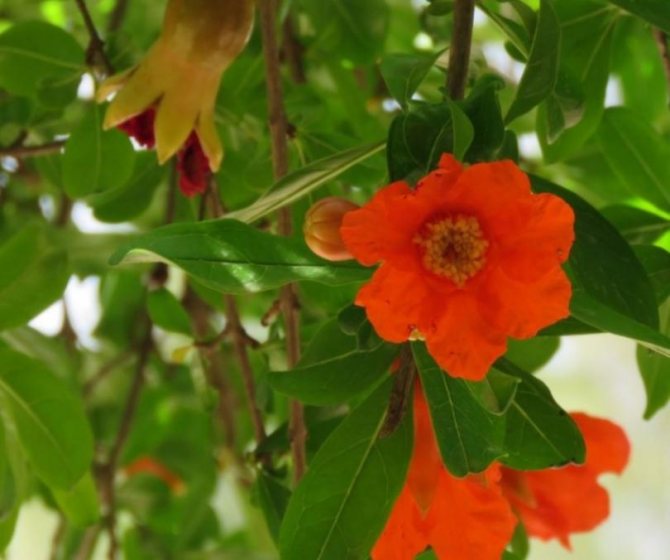

If you do this later and start cutting off green shoots with buds, the plant will only suffer and will take a very long time to recover! During the active growth period, only the shoots in the lower part of the trunk are cut off.
Insufficient air humidity. In dry air, the tree begins to wither. To increase the moisture in the air, you can apply spraying or place a container with a plant on a pallet with wet expanded clay.


The choice of planting material
Many people who want to plant a pomegranate are concerned about the question: where to get the fruit for planting? In a store or market. It can be purchased anywhere, but the main condition is its condition. A fruit with traces of mold and decay is not suitable for planting material. The seeds collected from such materials are poorly developed and do not produce significant fruits.
For planting, you need to purchase a ripe pomegranate, from which, after cutting in half, you can extract whole materials for planting. For germination, only those specimens that have a yellow tint and are similar to ivory are required. This shade means that they are mature enough and have the ability to grow.
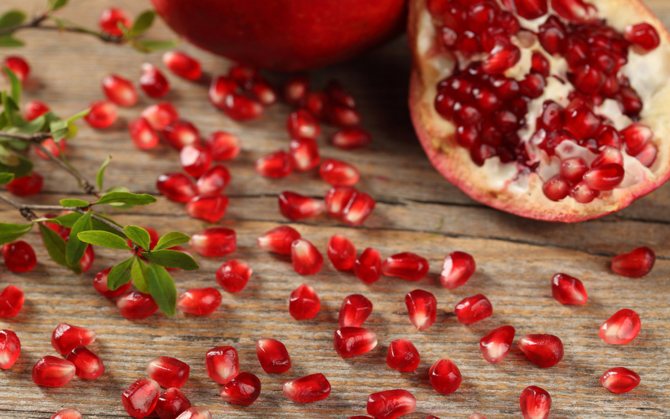

If you use green seeds, then they will not germinate, since the seeds are not ripe. Once in the ground, the green seeds will start to rot and will not grow.
Photo of pomegranate flowering
Transplanting a seedling into a larger pot
Seedlings should be planted in separate pots after two or three true leaves appear. The strongest and healthiest plants are selected. The pot for the first planting should not be large, a diameter of 7-10 cm is sufficient.
Pomegranate plant transplantation is not very well tolerated, usually they are transferred along with a lump of earth.
Seedlings are transplanted in this order:
- Prepare a pot with a diameter of 2-3 cm larger than the previous one.
- Drainage is placed on the bottom of the pot with a layer of 1–2 cm, then the soil is halfway up.
- Seedlings are removed carefully with a spoon or spatula along with the soil near the roots.
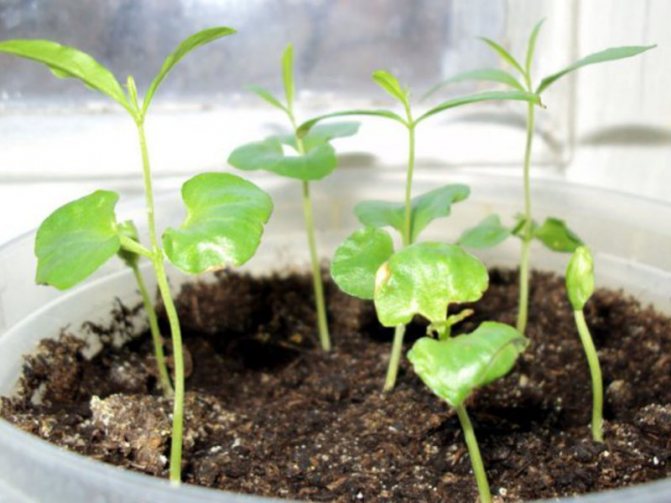

Pomegranate seedlings are taken out along with a clod of earth
- The plant is placed on the ground in the center of the new pot and the free space on the sides is covered with soil at the level of the earthen coma. It is not necessary to deepen - they will not bloom.
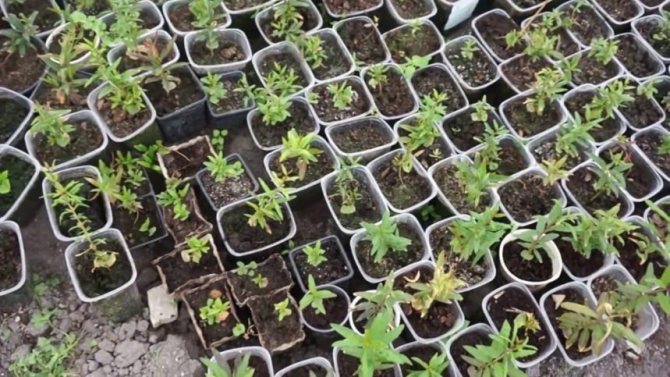

Each seedling is planted in the center of a separate pot.
- Watered with warm water and put in a sunny place.
For the first three years, the plants are replanted every year, gradually increasing the size of the pot. The transplant is carried out in the spring with swelling of the kidneys. Trees older than three years are replanted every three years or as needed. For an adult indoor plant, a five-liter pot is enough.... Too large a pot can stop flowering.
It should be noted that the pomegranate grows and blooms better in a slightly cramped pot.
Video: how to properly transplant indoor pomegranate
Possible problems
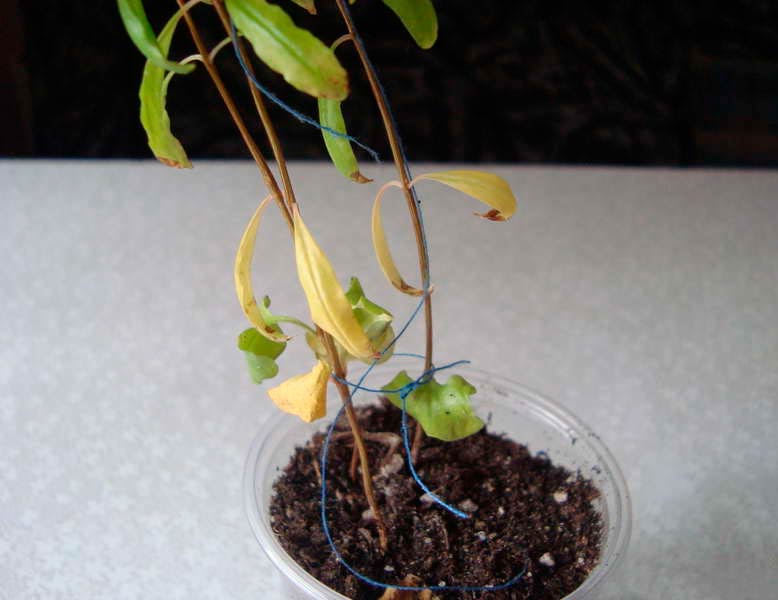

If you take care of the bush incorrectly or do not provide it with suitable growth conditions, then problems may arise with it:
- Yellowing of the tree... This problem is very common.To begin with, the bush must be carefully examined for the presence of harmful insects, in particular spider mites. If there are no pests, then the bush is likely to turn yellow due to the excessively high air temperature in the room. Also, yellowing may be associated with an insufficient amount of moisture in the soil mixture, but in this case, dark spots form on the leaf plates.
- Flying around foliage... The flying around of the leaf plates may be a consequence of their yellowing, and this may be due to the fact that pests, for example, spider mites, have settled on the bush, or the plant is affected by any disease, as well as with excessively poor watering or with the fact that in the room very hot. Flying around foliage can also be due to the fact that the plant is preparing for a dormant period, because it is deciduous. In this case, the process is quite natural and you should not be intimidated.
- Drying of a tree... Drying of foliage may be due to the fact that the humidity in the room is too low or with problems with the root system, which occur when the tree is watered incorrectly. In this case, the substrate in the pot must be sniffed, if it has a pungent smell of mold, then the bush will need to be transplanted into fresh soil mixture. During transplanting, carefully inspect the root system of the bush and cut out any decayed areas. The wounds on the surface of the root system must be sprinkled with coal powder.
What to do if the pomegranate does not bloom or does not set fruit
If your pomegranate is more than three years old, and it has never bloomed or pleased with fruits, then you need to reconsider the conditions of detention and care methods Check if you are doing everything correctly:
- The average daily temperature favorable for budding is 16 ... 18 ° C.
- There will be no flowers and fruits if the pomegranate is in the shade, the sun is not enough for it.
- Irregular watering and dry soil lead to crop failure.
- With an excess of moisture, the plant actively grows shoots and leaves to the detriment of fruiting. The same happens when applying nitrogen fertilizers. Potassium and phosphorus should prevail in dressings. Look at the composition of the mixtures and concentrates that you buy.
- The most fertile are 1–2-year-old shoots 10–40 cm long; excess trimmings interfere with their formation.
The uniqueness of the properties of a room grenade
It is not for nothing that many flower growers strive to grow pomegranates at home. The plant is not only very beautiful and decorative, but also has medicinal properties. In ancient times, it was considered a medicine capable of curing 100 diseases. It helps with many ailments.
The membranes are used to relieve blood pressure and also as a sedative. Pomegranate juice is also used as an excellent remedy for anemia, and is also recommended for people living in areas with an increased radiation background. For any inflammatory or colds, pomegranate will help relieve pain and quickly bring down the temperature.
In folk cosmetology, a paste from rubbed leaves has found wide application. It helps to get rid of pigmentation, reduces the oiliness of the skin and strengthens the hair. And in cooking, they use not only the juice and grains of this plant, but also flowers.
Care of young sprouts
As soon as the first seedlings appear, the container with seedlings must be placed in a bright place. It is also necessary to ensure that the soil does not dry out. It's better to water it by spraying from a spray bottle.
Seedlings with two or three true leaves are transplanted into separate pots. Young plants are planted in the ground, for the preparation of which you need to mix:
- leaf humus - 1 part;
- turf - 2 parts;
- sand - 0.5 parts;
- peat - 0.5 parts.
The pomegranate has a shallow root system, so the tree can grow in small containers. The main thing is good drainage.
Care for young plants consists in abundant and regular watering, which is carried out as the earthen mixture dries. The soil in the pots should always be slightly damp.Excess water must be poured out of the pan.
Plants planted in autumn during the winter season will need provide additional lighting... Otherwise, with a lack of light, the seedlings will elongate or will not grow at all.
Popular varieties of pomegranate for home
| Name | Description |
| Carthage, Baby | No more than a meter in height. Similar to common pomegranate, but smaller. Grown for decorative purposes, the fruits are not eaten. |
| Flore pleno | Grows in Persia, does not yield crops. It grows up to three to four meters. Bright scarlet inflorescences look like carnations. |
| Flore pleno alba | Similar to Flore Pleno, but with snow-white flowers. |
| Double flower | In one inflorescence there are petals of various shades: reddish, pinkish, snow-white. They are monochromatic or with stripes, interspersed. |
The Socotran pomegranate grows in the wild and is not kept at home. The homeland of the shrub is Socotra Island. The plant has abundant branching, small pink flowers, small fruits and rounded leaves.
Description
The shoots of the bush are covered with gray-brown wood. The leaf arrangement is opposite, whorled. The plates are wavy, with smooth edges. The outer side of the sheet is glossy, the inner side is matte. Blooms in funnel-shaped scarlet buds on shortened peduncles. Fruits are formed only in place of flowers that resemble jugs. Pomegranate blooms year-round.
Ordinary pomegranate is suitable for growing at home. In the wild, it grows up to 5-10 m. The diameter of the fruits reaches 8-18 cm. Breeders have bred a huge number of various forms and varieties from this species. Homes usually have a dwarf pomegranate It does not grow taller than one meter, has small leaves, and produces fruits no more than 3 cm.
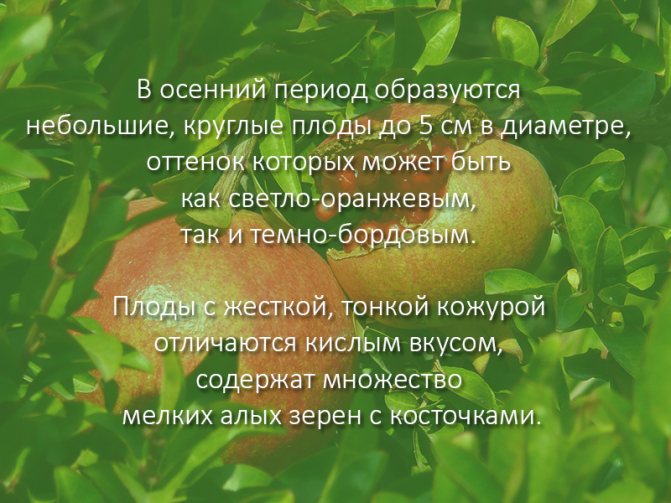

Content
- Listen to the article
- Description
- Seed pomegranate How to grow at home
- How to plant
- How to care for a seedling
- Watering
- How do they breed
- Beneficial features
Vitamins
The pomegranate fruit is a rich source of vitamins C, E, B and A, as well as many minerals and nutrients such as magnesium, phosphorus, potassium, calcium, silicon and iodine. The composition also contains a large amount of protein, fiber, folate and beta-carotene.
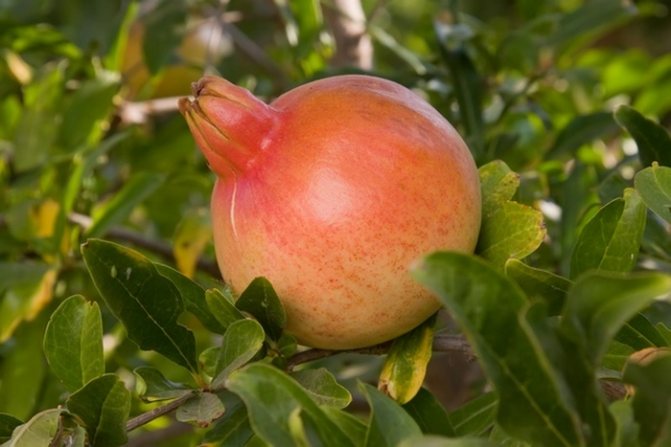

A 100 gram portion of fresh fruit has an average of about 80 kcal.
Origin
For the first time, they paid attention to pomegranate and began to grow it in gardens, on the territory of modern Tunisia (Ancient Carthage). The Romans called pomegranate "Punic apple", and in Latin "pomegranate" means "grainy". In ancient times, it was believed that the sweetest and juiciest fruits of the pomegranate can be found only in Carthage.
Currently, cultivated pomegranate plantations can be found in all regions of the planet with tropical climates. The fruits of the plant are rich in vitamins, sugars, and have a blood-restorative effect. Pomegranate seeds are used in cooking, from which the healing pomegranate juice is squeezed out.
Important! Undiluted plant sap can be damaging to tooth enamel. It is customary to dilute it with water by half or drink it through a straw.
Dwarf pomegranate varieties are grown as a houseplant, attractive in appearance and unpretentious.
Homeland of the plant
How the pomegranate tree blooms
When an adult pomegranate blooms, it is a stunning sight in its splendor. With the beginning of the flowering period, the buds appear one after the other, sequentially and without interruption. As soon as one flower blooms and falls, new flower buds appear the next day. The pomegranate tree stands in bloom for the entire fruiting period, at the same time forming fruits from the fertilized ovaries, new flower buds.
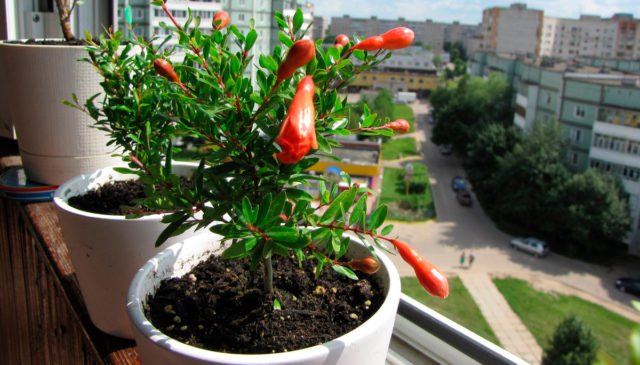

Pomegranate is beautiful at any time of the year, but in summer it is especially magnificent in flowers.
What does a pomegranate flower look like?
The pomegranate blooms with gorgeous, large flowers, 5 to 7 cm in diameter. The buds can be scarlet and orange-yellow, crimson and white, deep red, often combining all these colors in fancy tints.
Female buds are attached to the stem tightly, on a large base. The serrated edge of the dense shell becomes the future "crown" of the fetus. In the center there is a long pistil, significantly outstripping the stamens with pollen in growth. Such buds can appear only on strong, healthy shoots, at least two years old.
Male bells are thinner and more elongated, have a short pistil and long, developed stamens. Formed even on the shoots of the first year. Their life span is very short. The pomegranate is a self-pollinating plant, so no additional action or presence of bees is required when it blooms.
Attention! Sometimes the pomegranate blooms with buds of an indeterminate sex. Under favorable conditions, they can also give fruit ovaries.
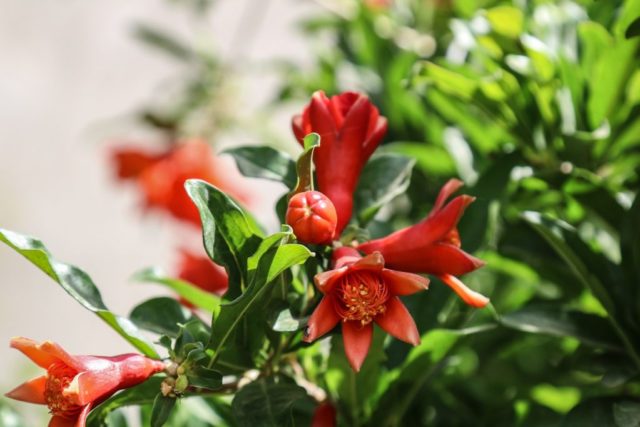

In the center of the bud there are numerous stamens with pollen and pistils
What is the name of the pomegranate flower
For their undoubted external similarity, pomegranate flowers are called depending on their gender:
- women - with jugs;
- men - with bells.
Attention! Male pomegranate flowers have only a fertilizing function, while the ratio of flowers can be regulated by agrotechnical methods.
Watering.
In the summer, water is plentiful, but without stagnation of water in the pan. Between watering, it is necessary to allow it to dry in the upper part of the substrate. With a decrease in temperature, the drying intervals must be increased, otherwise rotting of the root system is possible. If kept cool in winter, then watering is rarely necessary, as well as not allowing the substrate to be completely saturated with water. If the pomegranate is kept under normal conditions, it is not necessary to drastically reduce the amount of water.
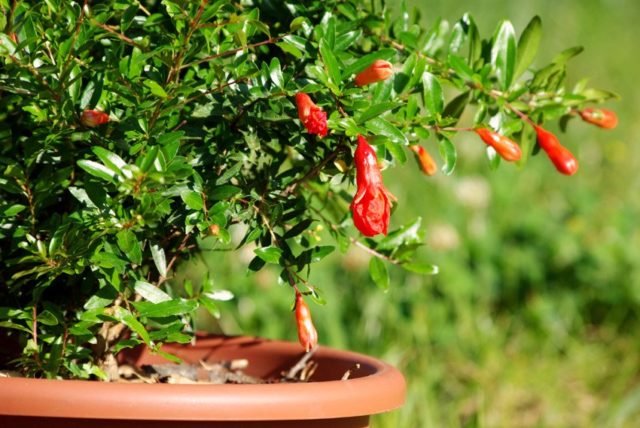

Healing properties
Pomegranate seeds contain a large amount of antioxidants that eliminate all harmful free radicals from the human body that cause cell destruction and damage. For this, juice extracted from the fruit is used. When buying juice at the grocery store, be sure to pay attention to the packaging. It must indicate that the product is 100% natural. You also need to make sure that this is not nectar, which contains practically nothing useful.
Antioxidants found in berries can slow down the accumulation of carcinogenic substances. This effect is due to the large number of amino acids that inhibit the development of the prostate, lung, esophagus or liver cancer. In addition, the use of fresh fruits has a positive effect on the human psyche. Experts recommend using pomegranate for those people who are prone to great stress.
However, the biggest plus of this fruit is that it increases libido. Pomegranate juice counteracts impotence in men, reduces male erection problems and has a positive effect on erotic sensations. In addition, members of the stronger sex who are undergoing anti-cancer treatment for the prostate should consume pomegranates. The substances contained in the fruits reduce the level of prostate antigen, which has a positive effect on the result of therapy.
In ancient times, pomegranate juice was considered the elixir of love, and the fruit itself was a symbol of good luck in family life and fertility.
It is also worth noting that the substances contained in pomegranate have a beneficial effect on the circulatory system and the functioning of the human heart. If you regularly consume this fruit, it will slow down the aging process of the skin. The peel of ripe fruits contains a large amount of tannins that are used in medicine. The leaves are used to make tea, and the roots are used to produce long-lasting black paint.
Reproduction methods
The home pomegranate tree is propagated by seeds, as well as by cuttings and grafting. It was already mentioned above that plants grown from seeds may not preserve the varietal characteristics of the parent plant, but the trees obtained in this way are suitable for grafting varietal cuttings. Plants obtained by cuttings or grown from cuttings completely retain the varietal characteristics of the parent bush.
Pomegranate from cuttings
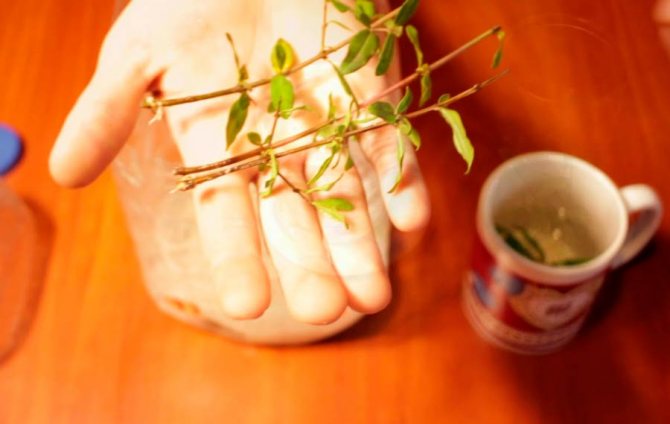

When harvesting cuttings, the growth of the current year is cut off, while their length should be about 10 centimeters. Root shoots can also be used for cutting cuttings. First, the lower cut of the cuttings is immersed in a solution of an agent that stimulates the formation of roots, they must stay there for 6 hours. Then the cuttings are washed under running water and planted in a soil mixture, which includes sand and peat (1: 1). The lower cut of the cuttings must be buried 20-30 mm into the substrate, after which the cutting must be covered from above with a cut plastic bottle or a transparent dome to create a greenhouse effect inside, which is necessary for successful rooting. Then the containers with cuttings are rearranged in a well-lit place. They should take root completely after 1.5-2.5 months, after which they are transplanted into individual pots, which are filled with soil mixture for citrus plants or a substrate consisting of turf, humus and leafy soil, and also sand (2: 1: 2: one). If a bush grown from a cuttings is well and properly looked after, then its first flowering may occur within 2 or 3 years after planting. The pomegranate tree can also be propagated by lignified cuttings, but their roots are formed for a very long time, while most of the cuttings die.
Reproduction by grafting
Indoor pomegranate is also propagated by grafting. If you plant a varietal cut on the stock of a pomegranate that was grown from seed, then you will get a varietal plant. Varietal cuttings that are suitable for grafting can only be taken from a fruiting bush. Different methods are suitable for grafting pomegranates, it all depends on the thickness of the scion cuttings and rootstock. Today there are more than 150 methods of vaccination, and it is up to you to decide which one is right for your particular case. The most popular among flower growers, as well as the simplest, are simple copulation, copulation with a tongue (English), behind the bark, into the cleft, into the butt and into the side cut. A successfully grafted plant should bloom for the first time after 3 or 4 years.
How to choose a fruit for planting a seed
For home cultivation, choose low-growing pomegranates, which can be planted in a pot, of the following varieties:
- Nana,
- Baby,
- Carthage.
The trees grow on average 40-100 cm in height.
You can buy pomegranate for collecting seeds at the store. But there is no guarantee that a tree will grow from them with the same fruits that the mother tree gives. As a rule, they sell hybrid varieties of pomegranate, the seeds obtained from them do not completely retain their parental characteristics.
If you still want to collect the seed yourself, you need to choose the right fruit. The guarantor must be large, undamaged, fully ripe. From rotten fruits, the seeds have poor germination.
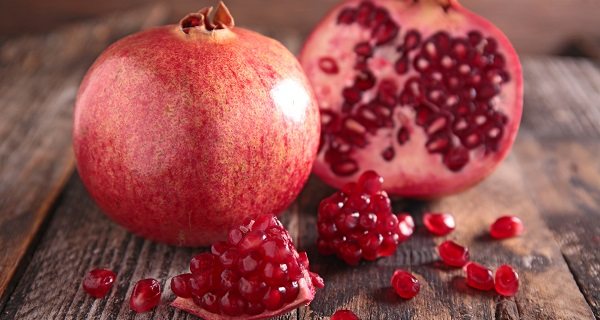

Crimean striped
This variety was bred as a result of the selection of the Nikitsky Botanical Garden. Outwardly, it is a Crimean striped pomegranate, a low-growing tree with a spherical crown. On average, the weight of one fruit is about 300 g. However, in some cases there are specimens weighing up to 450 g. Inside the fruit there are dark cherry grains, which taste sweet and sour. The fruit is covered with a thick skin. The variety has an average ripening period.
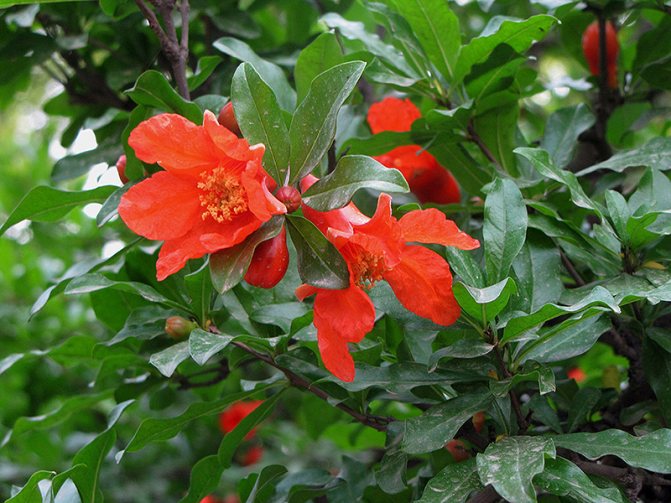

How to plant a tree for harvest
For grafting, you need a high-quality stalk. It is grafted onto a seedling with a diameter of about a finger thick. A stalk cut at an acute angle is inserted into the T-shaped incision in the bark.Its cut is completely immersed under the bark. After a month, the stalk will take root, and you can remove the bandage. This home-grown pomegranate will bear fruit well.
